Home » Posts tagged 'google voice' (Page 14)
Tag Archives: google voice
Incredible PBX on Steroids: The Asterisk-GUI Project Rolls On (Chapter 3)

We’re big fans of the new hybrid vehicles especially the Cadillac ELR. It combines an electric motor with a gas generator to give you the best of both worlds. For in-town driving, you get terrific performance at 1.5¢/mile using pure electric power. But you’re not hamstrung from venturing out to anywhere you choose using a traditional gas engine that can be refueled quickly at any time. In a nutshell, that’s the design philosophy that’s inspired development of Incredible PBX for the Asterisk-GUI.
This is the third installment in our series. You can catch up with the Overview as well as Chapter 1 and Chapter 2 here.
With Incredible PBX for the Asterisk-GUI, you get a terrific GUI to manage Asterisk® while taking advantage of all the neat features that Incredible PBX brings to the table using traditional dialplan design. Stated another way, you’re not being forced to always use a GUI to manage your Asterisk server when command-line utilities are more functional or efficient. Previous approaches to GUI-only management of Asterisk forced you to always jump through the GUI hoops to do much of anything. Unfortunately, what you lost in that scenario was a lot of the native functionality of Asterisk.
That’s not to say there wasn’t a lot to like about our GUI heritage with Asterisk. These open source projects brought a wealth of features to the table for beginners without having to learn much about the way Asterisk actually worked. The downside was you didn’t learn much about the way Asterisk actually worked. On the one hand, it kept folks from making serious programming errors that could result in major phone bills when security issues crept into a dialplan. The drawback was you never learned why. When something came unglued and things do come unglued, you were up the proverbial creek without a paddle. In fact, many never knew they had a paddle much less what it looked like.
I wish I had a nickel for every user that’s complained over the years that Asterisk won’t start. The last time we checked Google was showing 963,000 of them. It turns out that many of these weren’t failures with Asterisk at all but rather shortcomings in the interaction of one particular graphical user interface with MySQL. If you don’t believe it, shut down MySQL on your existing Asterisk server and then try to restart Asterisk. You’ll never see this with Incredible PBX for Asterisk-GUI. Why? Because the reliability of Asterisk isn’t tied to the reliability of MySQL, Apache, Perl, Asterisk-GUI, or any other foreign application.
**** WARNING: ERROR IN CONFIGURATION **** astrundir in '/etc/asterisk' is set to but the directory does not exists. Attempting to create it with: 'mkdir -p ' mkdir: missing operand Try 'mkdir --help' for more information. **** ERROR: COULD NOT CREATE **** Attempt to execute 'mkdir -p ' failed with an exit code of 1 You must create this directory and the try again.
In the new Incredible PBX design, we haven’t forgotten about security either. In this day and age, it’s the single most important feature of any PBX that is connected to the Internet. We always recommend running your server behind a hardware-based firewall with no Internet port exposure, but we appreciate that’s not always possible particularly with Cloud-based servers. Incredible PBX is delivered with the Linux IPtables firewall preconfigured. It allows access from your server’s IP address, from the IP address used to install Incredible PBX, from private IP addresses on your local area network, and from a very limited set of trusted providers so that you can connect your trunks to make and receive phone calls. The tools to add and delete whitelist entries on your firewall are also included. In addition, we’ve included the PortKnocker utility which lets remote users with the three port knock codes gain access until their IP addresses can be whitelisted by an administrator. In addition to IPtables security, there’s another layer of protection for web-based applications. Asterisk-GUI, of course, has its own security system that’s tied to the Asterisk manager.conf setup. All of the remaining web applications require Apache authentication. For Reminders and AsteriDex, you can create multiple Apache passwords for individual users or groups of users. For administrator applications, you set an admin password that’s only known by administrators.
We couldn’t help chuckling recently when one of the security sites found a vulnerability in one of the Incredible PBX applications but noted that administrator access was required to get to the application to launch the attack. That’s akin to saying your system is vulnerable if you hand out your root user credentials AND whitelist the IP addresses of the bad guys. Literally, what was documented was true, but finding security issues in software that requires root permissions for access is getting a little desperate, wouldn’t you say? Of course, one of our "competitors" wasted little time splashing it all over their web site. The vulnerability was fixed the same day it was disclosed, by the way. And it was automatically pushed out to every Incredible PBX server, all of which run industry-standard Linux operating systems. That’s the approach to system design and support our users have come to expect. Feel free to compare it to the offerings you’ll find elsewhere, commercial or otherwise. That, my friends, is what freedom of choice is all about.
The Lean, Mean (Pure) Asterisk Machine
The roadmap for the future direction of Incredible PBX continues to evolve, but let us take a moment and share our current thinking. We’ve previously mentioned that the target audience for Incredible PBX for Asterisk-GUI is hobbyists. That’s not a dirty word in our book. Nor does it mean the platform won’t be as robust and reliable as previous releases of Incredible PBX. It just has a smaller memory footprint and much faster performance. Yes, we’re using Asterisk-GUI which Digium no longer supports. But that was a marketing decision that had nothing to do with the quality of the product. It was written by some of the best brains in the Asterisk business so we’re comfortable using it as a platform. We’ve found only two bugs in beating on the software relentlessly. Outbound Caller ID on a per extension basis can be quirky. Trunk-based CallerID whether assigned at the provider end or on Incredible PBX works just fine including CallerID spoofing where permitted by the provider. The other wrinkle was Asterisk-GUI’s failure to support the [context](+) feature of Asterisk. We’ve found an easy workaround for that one as well. We just won’t use it.
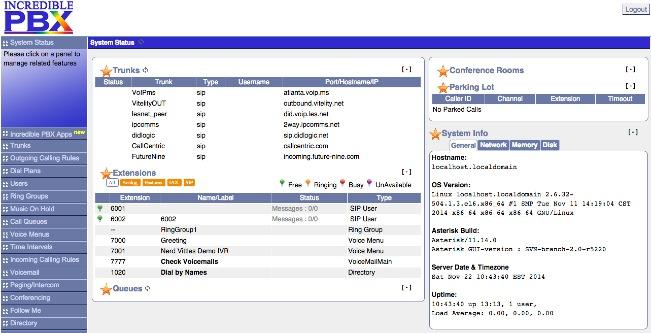
The plan is to roll this out first on the CentOS 6.5 (now 6.6) platform because we view it as the most stable. Scientific Linux 6.6 works equally well. Once we get any kinks out of the code, we’ll turn our attention to Ubuntu 14 and then on to the small hardware: Raspberry Pi, BeagleBone Black, CuBox, and PogoPlug. There’s also been interest in a more internationally-friendly version, and that’s on the drawing board as well. During the rollout, we hope to complete work on moving a few MySQL-based utilities to SQLite3. We will leave MySQL in the installation mix but will turn it off to further reduce the memory overhead of the install. We also will scale back the number of simultaneous Apache sessions running since the purpose of Apache is primarily to support administrator utilities on the server. Actually, you can run Asterisk-GUI using either the native Asterisk http server or with Apache. Thanks to Bill Simon of Simon Telephonics, you’ll have both options. With simple modifications, we think we can improve the performance on memory-constrained platforms dramatically while providing a robust, high performance platform if you have the hardware to support it. We’ve also initiated discussions with Amazon to roll out a phone service using this platform for the new Amazon Echo product. So 2015 is shaping up to be another banner year in the VoIP world. We hope you’ll come join us.
This week we continue the march. We want to review some of the open source features being incorporated into Incredible PBX from the open source code base minus some of the superfluous GUI modules. For example, you can manage blacklisting of callers using nothing more than your telephone. The same is true for SMS messaging. If you can dictate an SMS message, then why type it? Bash scripts are a well-tested feature of Incredible PBX, and you’ll still find a healthy collection of them in the /root folder of your server after you complete the install. But today’s focus is what can be accomplished with Incredible PBX using nothing more than your telephone.
Blacklisting Callers with Incredible PBX
One of our old PBX favorites dating back to the Asterisk@Home days was blacklisting. This means that old girlfriends and telemarketers get routed to Zapateller with a message that your number is not in service. By default, Incredible PBX for Asterisk-GUI will automatically blacklist incoming calls without a CallerID number. You can modify this behavior if desired:
asterisk -rx "database del blacklist blocked"
If you change your mind and want to turn anonymous call blocking back on, use this command:
asterisk -rx "database put blacklist blocked 1"
We’ve retained the same feature codes to manage blacklisting of specific numbers from any phone on your system:
- *30 – Add a number to Blacklist
- *31 – Remove number from Blacklist
- *32 – Blacklist last number that called
Blacklisting was all smoke and mirrors in the old GUI days. But we want you to understand how this actually works so that you can change it if you’d like. For example, instead of the Zapateller tone, you might prefer to route callers on your blacklist to Lenny (53669 on your phone) so that you waste some of the caller’s time instead of the other way around.
In the extensions_additional.conf file, find the [app-blacklist-check] context. The last four lines in that context look like this:
;exten => s,n,Goto(DLPN_DialPlanMain,53669,1) exten => s,n,Zapateller() exten => s,n,Playback(ss-noservice) exten => s,n,Hangup
To route blacklisted callers to Lenny, just uncomment the top line shown and add semicolons to the next two lines:
exten => s,n,Goto(DLPN_DialPlanMain,53669,1) ;exten => s,n,Zapateller() ;exten => s,n,Playback(ss-noservice) exten => s,n,Hangup
Wasn’t that easy? Now just save your changes and reload your dialplan: asterisk -rx "dialplan reload"
You may prefer to manually add numbers to your blacklist. You can do this from the Linux command prompt like this. Don’t forget the 1.
asterisk -rx "database put blacklist 8005551212 1"
From the Asterisk CLI (asterisk -rvvvvvvvvvv), do it like this:
database put blacklist 8005551212 1
To display all of your blacklist entries, try this:
database show blacklist
To remove an entry from the blacklist, use this syntax:
database del blacklist 8005551212
MP3 Voicemail Messaging for Cellphone Playback
One of the most requested features on our forums has been the ability to forward voicemails in MP3 format so that they play back correctly on cellphones and desktop mail clients. As with many of the Incredible PBX features, we wouldn’t know where to start to thank all of the folks that helped make this happen. You can review the thread on the PIAF Forum for background. This is yet another great example of how the open source community should work. Thanks to everyone that participated in bringing this development to fruition. On the new Incredible PBX for Asterisk-GUI platform it’s automatic. All you have to do is assign an email address to any voice mailbox on your server in the Users setup, and incoming voicemail messages will be delivered by email in the proper format for playback. The message thread explains how for those with an interest.
Accessing Voicemail Messages with Incredible PBX
Speaking of voicemail, we’ve tried to maintain the same feature codes that many have become accustomed to over the years. Here’s a recap of the codes in case you ever forget:
- *98 – Check Voicemail Messages from Any Phone
- *extension – Leave a Voicemail for Dialed Extension
- * after voicemail connect – Access Voicemail Retrieval
Migrating the Google Speech Feature Set to Incredible PBX for Asterisk-GUI
We previously mentioned that Google Voice wasn’t around when Asterisk-GUI was developed. Not to worry. We’ve added it. And that’s just the beginning. All of the Google features that have made Incredible PBX so popular will be included in the Asterisk-GUI edition. That includes text-to-speech and speech recognition thanks to Lefteris Zafiris. It also includes SMS messaging with your same Google Voice credentials. Pick up a phone and dial S-M-S to dictate and send an SMS message to any recipient in the U.S. or Canada. Pick up a phone and dial 949 to listen to a weather forecast for any major city in the world. Just say the name of the city and state or country. Pick up a phone and dial 951 to listen to the latest News Headlines. Or dial T-O-D-A-Y to listen to Today in History. Sign up for a free Wolfram Alpha key, dial 4747, and you’ve got a voice-enabled encyclopedia at your fingertips. Eat your heart out, Siri. Our extra special thanks to Google for still supporting the open source community. Did we mention… It’s all still free.
Google has changed the rules a bit on using their speech recognition engine. So you now need an API Key to use the Speech Recognition AGI script for Asterisk. Assuming you’ll be using the functionality for “personal and development use,” here’s how to obtain your API key:
1. IMPORTANT FIRST STEP: Use an existing Google/Gmail account to join the Chrome-Dev Group.
2. Using the same account, create a new Speech Recognition Project.
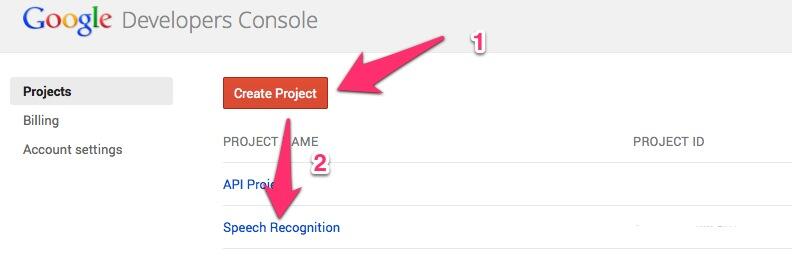
3. Click on your newly created project and choose APIs & auth.
4. Turn ON Speech API by clicking on its Status button in the far right margin.

5. Click on Credentials in APIs & auth and choose Create New Key -> Server key. Leave the IP address restriction blank!
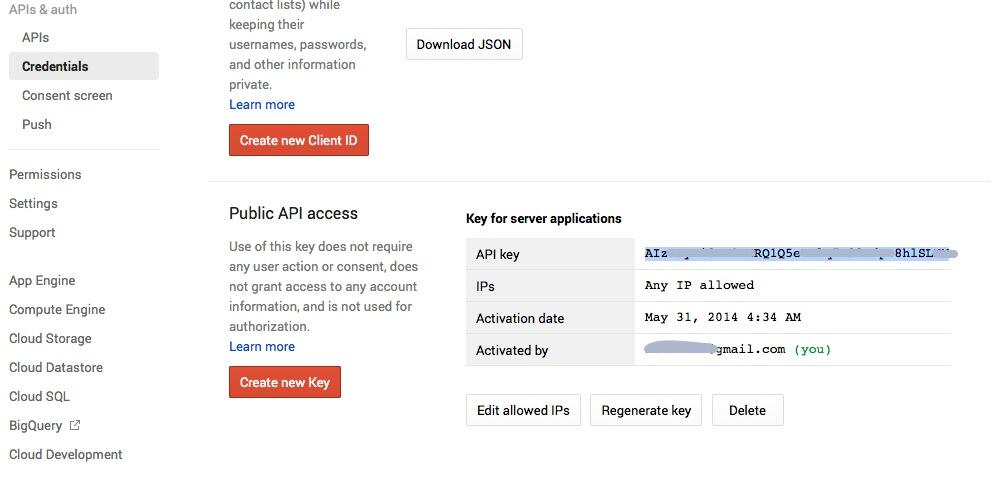
6. Write down your new API key or copy it to the clipboard.
7. Once you’ve installed Incredible PBX, log into your server as root and edit speech-recog.agi in /var/lib/asterisk/agi-bin.
8. Go to line 70 of speech-recog.agi: my $key = "". Insert your API key from Step #6 above between the quotation marks and save the file: Ctrl-X, Y, then Enter.
This will activate all of the Speech Recognition applications in Incredible PBX as described above.
Activating Wolfram Alpha with Speech Recognition in Incredible PBX
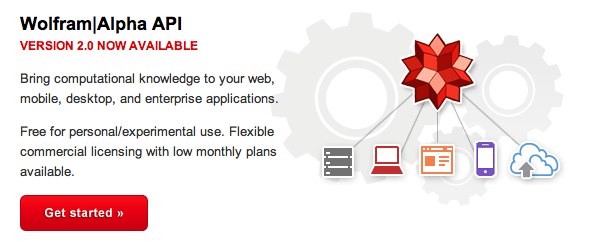
If you’re not familiar with Wolfram Alpha, it’s an encyclopedia and almanac on steroids. It’s driven by a supercomputer. There’s not much it doesn’t know. We’ve written an exhaustive article on Wolfram Alpha for Asterisk so start there. With Incredible PBX, everything is preconfigured for you. All you need to do is obtain a (free) API key.
To get started, sign up for a free Wolfram Alpha API account. Just provide your email address and set up a password. It takes less than a minute. Log into your account and click on Get An App ID. Make up a name for your application and write down (and keep secret) your APP-ID code. That’s all there is to getting set up with Wolfram Alpha. If you want to explore costs for commercial use, there are links to let you get more information.
Now you’ll need to insert your API key into /var/lib/asterisk/agi-bin/4747. The first line of the file looks like this: APPID="Wolfram-Alpha-API-Key-Goes-Here". Insert your API key between the quotation marks and save the file: Ctrl-X, Y, then Enter.
You’re ready to try out Wolfram Alpha by dialing 4-7-4-7 from any phone connected to your server. Here are some sample queries to get you started:
Weather in Charleston South Carolina
Weather forecast for Washington D.C.
Next solar eclipse
Otis Redding
Define politician
Who won the 1969 Superbowl? (Broadway Joe)
What planes are overhead? (flying over your server’s location)
Ham and cheese sandwich (nutritional information)
Holidays 2015 (summary of all holidays for 2015 with dates and DOW)
Medical University of South Carolina (history of MUSC)
Star Trek (show history, air dates, number of episodes, and more)
Apollo 11 (everything you ever wanted to know)
Cheapest Toaster (brand and price)
Battle of Gettysburg (sad day 🙂 )
Daylight Savings Time 2015 Charleston South Carolina (date ranges and how to set your clocks)
iPads by Apple (pricing, models, and specs from Best Buy)
Doughnut (you don’t wanna know)
Snickers bar (ditto)
Weather (local weather at your server’s location)
Yahoo! Weather by ZIP Code Is Moving to SQLite 3
One of the more popular features of Incredible PBX has always been the ability to retrieve a Yahoo weather forecast by dialing Z-I-P and plugging in a 5-digit ZIP code for the weather report you wished to hear. This always required a MySQL zip code database to translate the zip code into a city and state for presentation to the various weather services. As part of our move to reduce the memory footprint of Incredible PBX, we are gradually removing our dependence on MySQL. In its place we’re deploying SQLite3 databases, and Weather by ZIP Code was our first successful migration. Moving the MySQL zip code database to SQLite was a snap using a terrific open source script that we highly recommend to developers. It lets you convert any MySQL database (with indexes) to SQLite 3 in seconds. Here’s the link if you ever have the need. About 5 lines of PHP code had to be modified to complete the migration from MySQL to SQLite. Not bad. For our purposes, you’ll never know the difference when you dial in for your next weather forecast.
Originally published: Monday, December 15, 2014

Need help with Asterisk? Visit the PBX in a Flash Forum.
Special Thanks to Our Generous Sponsors
FULL DISCLOSURE: ClearlyIP, Skyetel, Vitelity, DigitalOcean, Vultr, VoIP.ms, 3CX, Sangoma, TelecomsXchange and VitalPBX have provided financial support to Nerd Vittles and our open source projects through advertising, referral revenue, and/or merchandise. As an Amazon Associate and Best Buy Affiliate, we also earn from qualifying purchases. We’ve chosen these providers not the other way around. Our decisions are based upon their corporate reputation and the quality of their offerings and pricing. Our recommendations regarding technology are reached without regard to financial compensation except in situations in which comparable products at comparable pricing are available from multiple sources. In this limited case, we support our sponsors because our sponsors support us.
 BOGO Bonaza: Enjoy state-of-the-art VoIP service with a $10 credit and half-price SIP service on up to $500 of Skyetel trunking with free number porting when you fund your Skyetel account. No limits on number of simultaneous calls. Quadruple data center redundancy. $25 monthly minimum spend required. Tutorial and sign up details are here.
BOGO Bonaza: Enjoy state-of-the-art VoIP service with a $10 credit and half-price SIP service on up to $500 of Skyetel trunking with free number porting when you fund your Skyetel account. No limits on number of simultaneous calls. Quadruple data center redundancy. $25 monthly minimum spend required. Tutorial and sign up details are here.
 The lynchpin of Incredible PBX 2020 and beyond is ClearlyIP components which bring management of FreePBX modules and SIP phone integration to a level never before available with any other Asterisk distribution. And now you can configure and reconfigure your new Incredible PBX phones from the convenience of the Incredible PBX GUI.
The lynchpin of Incredible PBX 2020 and beyond is ClearlyIP components which bring management of FreePBX modules and SIP phone integration to a level never before available with any other Asterisk distribution. And now you can configure and reconfigure your new Incredible PBX phones from the convenience of the Incredible PBX GUI.
 VitalPBX is perhaps the fastest-growing PBX offering based upon Asterisk with an installed presence in more than 100 countries worldwide. VitalPBX has generously provided a customized White Label version of Incredible PBX tailored for use with all Incredible PBX and VitalPBX custom applications. Follow this link for a free test drive!
VitalPBX is perhaps the fastest-growing PBX offering based upon Asterisk with an installed presence in more than 100 countries worldwide. VitalPBX has generously provided a customized White Label version of Incredible PBX tailored for use with all Incredible PBX and VitalPBX custom applications. Follow this link for a free test drive!
 Special Thanks to Vitelity. Vitelity is now Voyant Communications and has halted new registrations for the time being. Our special thanks to Vitelity for their unwavering financial support over many years and to the many Nerd Vittles readers who continue to enjoy the benefits of their service offerings. We will keep everyone posted on further developments.
Special Thanks to Vitelity. Vitelity is now Voyant Communications and has halted new registrations for the time being. Our special thanks to Vitelity for their unwavering financial support over many years and to the many Nerd Vittles readers who continue to enjoy the benefits of their service offerings. We will keep everyone posted on further developments.
Some Recent Nerd Vittles Articles of Interest…
Incredible PBX on Steroids: The Asterisk-GUI Dial Plan Basics (Chapter 2)
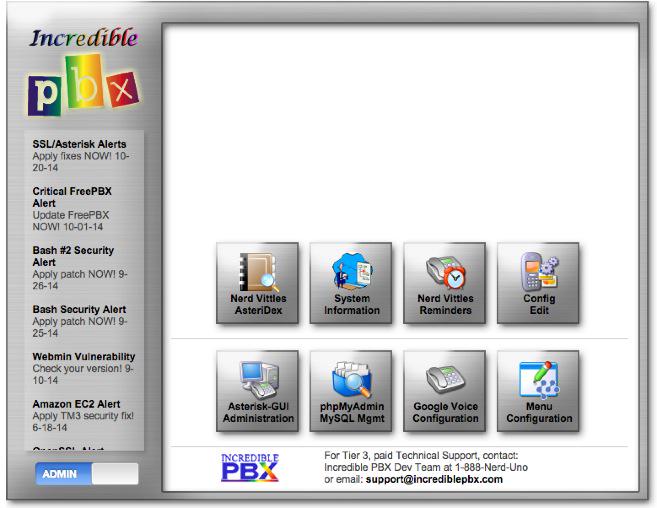
We’re making steady progress on the Incredible PBX for Asterisk-GUI project. If you didn’t read last week’s introductory article, start there. This week we’ve had to wrestle with one of the stark realities of taking someone else’s turnkey code and attempting to bolt on enhancements. As previously noted, Asterisk-GUI works all of its magic by manipulating Asterisk® config files directly with no outside storage of settings in either MySQL or the Asterisk DB. This is a good thing… at least until you try to add new features while leaving the basic Asterisk-GUI code intact. That was one of our primary objectives.
This is the second installment in our series. You can catch up with the Overview as well as Chapter 1 and Chapter 3 here.
Simplifying Credentials Management with Incredible PBX
Here’s the problem. We wanted to separate out the credentials for various providers so it would be easy for first-time users to set up a server without having to master Asterisk or the Asterisk-GUI. As we mentioned, this has been the number #1 complaint with the FreePBX® way of doing things. You almost needed to go back to college for another degree before you could make your first phone call. To get a functional VoIP server with one extension and one outbound trunk, it required creation of an extension, registration of a trunk with obscure settings that are different for almost every provider, creation of an inbound and outbound route with settings for how to actually route the calls in and out. And then there was configuration of some less-than-intuitive SIP settings. That’s before you ever start thinking about security and a firewall. Life’s too short!
But we encountered some stumbling blocks with Asterisk-GUI as well. It was rewriting our credentials_sip.conf file whenever Asterisk-GUI was actually used to add a new user (extension) or trunk. Worse yet, it was rewriting the entries incorrectly because the developers forgot about a special syntax in Asterisk that we’ll get to in a minute.
We first thought we could solve the rewriting of our config files by limiting write permissions on our new credentials files to the root user. Asterisk and Asterisk-GUI both run as the asterisk user so this would have been an easy fix. Well, no cigar. Asterisk-GUI outsmarted us by quietly aborting the update when it didn’t have ownership of our .conf files. This meant you never could use the Asterisk-GUI for much of anything, not exactly what we had in mind.
Lucky for us, one of the developers forgot about our favorite Linux utility, chattr. This lets you set the immutable bit to prevent all users (including root) from changing the contents of a file. Since Asterisk-GUI sometimes skips error checking after it’s sure it owns the .conf files, it was perfect. We could "hide" settings in our own credentials_sip.conf file without worrying that they’d be overwritten by Asterisk-GUI. The only trick is remembering to turn the immutable bit off when we want to make updates and, of course, turning it back on once we’re finished so that Asterisk-GUI doesn’t mangle the settings when you use Asterisk-GUI for other things. Of course, it also means you’ll need to log in as root to set up credentials for the "Incredible 9″ trunks, but that’s a walk in the park. In fact, that’s the beauty of using chattr in the first place.
For those that love to wade into the weeds of Asterisk design, there is another feature which permits storage of additional settings for any [context]. You simply create [context](+) in a separate file using the same name as the original context. When you reload Asterisk, it blends all of the entries from the two contexts. That’s exactly what we needed in order to simplify storage of credentials for providers using our own config files. Unfortunately, the Asterisk-GUI developers forgot about this syntax and removed our [context](+) entries presumably thinking they were bad code. This left the credentials themselves sitting in a config file with no context, and that wreaked all sorts of havoc in Asterisk-GUI. So now you know why we needed write protection for our credentials_sip.conf file.
Speaking of credentials, here’s how the default credentials_sip.conf file actually looks. To edit the file, you start by removing the immutable bit: chattr -i credentials_sip.conf. Never comment out the host entries or Asterisk dies! Host names may need to be changed depending upon the server on which your provider sets up your individual account. Everything else is simple enough for anyone to master without a tutorial. Plug in your ACCTNAME and ACCTPASS and uncomment the affected lines by removing the semicolons for any trunk you wish to use. Save your settings. Don’t forget to reprotect the file when you’re finished: chattr +i credentials_sip.conf. Finally, restart Asterisk: service asterisk restart. We plan to add scripts to automatically manage these trunk settings, but we wanted you to know how everything actually worked so you can do it yourself should you ever feel the urge.
[voipms](+) ; VoIP.ms trunk Prefix: Dial 9 ;username = ACCTNAME ;secret = ACCTPASS host = atlanta.voip.ms [Vitelity](+) ; Vitelity trunk Prefix: Dial 8 ;username = ACCTNAME ;secret = ACCTPASS host = inbound1.vitelity.net [lesnet_peer](+) ; Les.net trunk Prefix: Dial 7 ;username = ACCTNAME ;secret = ACCTPASS host = did.voip.les.net [ipcomms](+) ; IPcomms trunk Prefix: Dial 6 ;username = ACCTNUM ;fromuser = ACCTNUM ;secret = ACCTPASS host = 2way.ipcomms.net [didlogic](+) ; DIDlogic trunk Prefix: Dial 5 ;username = ACCTNUM ;secret = ACCTPASS host = sip.didlogic.net [CallCentric](+) ; CallCentric trunk Prefix: Dial 4 ;username = ACCTNUM ;fromuser = ACCTNUM ;authuser = ACCTNUM ;secret = ACCTPASS host = callcentric.com [FutureNine](+) ; FutureNine trunk Prefix: Dial 3 ;username = ACCTNUM ;secret = ACCTPASS host = incoming.future-nine.com
I hear some of you squawking, "Why do you call it ‘Incredible 9’ when there are only 7 providers?" The answer is that Google Voice is managed separately in credentials_googlevoice.conf because it operates differently in Asterisk. Anveo Direct also has a different way of handling outbound SIP calls. A PIN is required as part of the dial string. That PIN is managed separately in credentials_extensions.conf. So… 7 + 2 = 9.
Linux Application Framework for Incredible PBX
We also wanted to simplify the process of adding new Linux utilities to our Incredible PBX setup for Asterisk-GUI. You may know that Asterisk-GUI runs under a lean, mean web server that’s actually part of Asterisk. By default, it operates on port 8088. We wanted to leave it that way to simplify the procedure for compiling Asterisk to run as the asterisk user as opposed to the root user. The Asterisk web server never was intended to compete with Apache, and there is no support for PHP much less MySQL. In order to use the dozens of Incredible PBX utilities and databases as well as all of the text-to-speech and speech recognition tools, we needed Apache, PHP, and MySQL. So our design decision was to run Apache on port 80 with full PHP support and then run MySQL in the same way it has been installed on LAMP servers since Day One.
That design meant we still needed a separate web site to support Incredible PBX utilities. Luckily, our friends at Kennon Software built a beautiful user interface for PBX in a Flash many years ago. With some minor tweaking to account for newer releases of PHP, it was a perfect fit for Incredible PBX as you can see at the top of this article. It has all the things we were looking for including an RSS Feed to provide emergency announcements. It also provides developers unlimited flexibility to add local applications and make other modifications as desired for both end-users and administrators. So our tip of the hat again goes to Kennon Software for their terrific open source contribution to our projects.
Choosing a Linux Platform for Incredible PBX
Speaking of Linux, we’re often asked what’s the best Linux platform on which to run Incredible PBX. Our stock answer is ALL OF THE ABOVE. Incredible PBX has been and is being engineered to run well on almost any Linux platform. We plan to initially release Incredible PBX for Asterisk-GUI on the CentOS/Scientific Linux 6.5 platform, but we’ll add Ubuntu 14.04 and Debian in coming weeks. In this way, we can support all of our favorite low-cost hardware platforms including the Raspberry Pi, BeagleBone Black, CuBox, PogoPlug, and anything else we can get our hands on.
Adding Inbound & Outbound Dialplan Code to Incredible PBX
This week we also tackled some of the other items on the Wish List. We’ve heard from a number of folks that wanted a simple way to add customized dialplan code whenever a call was made or received. That was an easy one. In extensions_custom.conf, you’ll now find the following contexts which can be enhanced in any way you choose. Just plug your additional code into each context between the two default entries.
[incoming-sub]
exten => incoming-sub_1,1,Noop(*** Incoming: ${CALLERID(all)} on ${CHANNEL} ***)
exten => incoming-sub_1,n,Return()
[outgoing-sub]
exten => outgoing-sub_1,1,Noop(*** Calling: ${CALLERID(dnid)} from ${CALLERID(all)} ***)
exten => outgoing-sub_1,n,Return()
Managing Incoming Calls to "Incredible 9″ Trunks
We haven’t (yet) come up with a really simple way to adjust how inbound calls to our preconfigured trunks are processed because of the basic Asterisk-GUI design. In a nutshell, incoming calls come into your PBX on a phone number, aka DID. That DID is associated with a trunk that you’ve registered to a specific provider. Once the call hits Incredible PBX, we need to tell the PBX where to route the call. Typical choices include an extension, a group of extensions (i.e. a ring group), an IVR, or an AutoAttendant. There are others. In extensions.conf, you will find the dialplan code to manage incoming calls to the "Incredible 9″ trunks. The setup for each of the 9 trunks looks like this:
[DID_Vitelity]
include = DID_Vitelity_default
[DID_Vitelity_default]
exten = _.,1,Set(CALLERID(name)=${CALLERID(number)})
exten = _.,n,Set(CALLERID(number)=${CALLERID(number):0:10})
exten = _.,n,Gosub(cidlookup,cidlookup_1,1())
exten = _.,n,ExecIf($[ "${CALLERID(name)}" = "" ] ?Set(CALLERID(name)=${CALLERID(num)}))
exten = _.,n,Gosub(incoming-sub,incoming-sub_1,1())
;exten = _.,n,Goto(default,6001,1)
;exten = _.,n,Goto(ringroups-custom-1,s,1)
;exten = _.,n,Goto(voicemenu-custom-2,s,1)
exten = _.,n,Goto(voicemenu-custom-1,s,1)
[CallingRule_OutVitelity]
exten = _8NXXNXXXXXX,1,Macro(trunkdial-failover-0.4,${Vitelity}/${EXTEN:1},,Vitelity,)
exten = _81NXXNXXXXXX,1,Macro(trunkdial-failover-0.4,${Vitelity}/${EXTEN:2},,Vitelity,)
In the Asterisk-GUI world, a [DID_provider] context manages incoming calls FROM a provider’s DID or trunk. And a [CallingRule_provider] context manages outbound calls TO your provider’s trunk. In the default Vitelity setup, incoming Vitelity calls get routed to voicemenu-custom-1, and outbound calls with an 8 prefix get routed out through your Vitelity trunk. As noted, all of these contexts can be found in extensions.conf.
Toward the end of the default context you will see two voicemenu-custom entries as well as a ringroups-custom-1 entry and a default entry with an extension number. All but one of these is commented out. As you have probably guessed, the uncommented entry determines where the incoming call is routed. When you create IVRs or ring groups in Asterisk-GUI, each new creation gets assigned a sequential number starting with 1. ringroups-custom-1 is a preconfigured Ring Group that currently sends calls to extensions 6001 and 6002, the two extensions created in the Incredible PBX default setup. If you add additional extensions and then add those new numbers to this preconfigured ring group, then those phones will ring as well. It does NOT change the sequential number originally assigned to this ring group. Adding a new ring group does that.
In Asterisk-GUI, IVRs and AutoAttendants are called Voice Menus. Incredible PBX ships with two. Voice Menu #1 is the Nerd Vittles’ Stealth AutoAttendant. It greets the caller with a cheery message from Allison while providing a couple seconds for someone (like you) to press a button to reroute the call to an undisclosed destination. If no key is pressed, the incoming call is routed to Ring Group #1.
Voice Menu #2 is a Demo IVR that showcases many of the Nerd Vittles applications. By default, all "Incredible 9″ trunks are configured to route incoming callers through the Stealth AutoAttendant to Ring Group #1. If you’d prefer to route incoming calls to a ring group or a particular extension or the demo IVR, the commented out entries will let you do that.
But suppose you wanted to route an incoming call to a custom extension defined in extensions_custom.conf? Well, it’s easy. Just change the context to CallingRule_extensions_custom and route the call to line 1 of the extension context desired. For example, to send an incoming call to the AsteriDex Voice Dialer (411) which lets callers say the name of the party they wish to reach, you’d insert a call destination entry that looked like this:
exten = _.,n,Goto(CallingRule_extensions_custom,411,1)
Better yet, you can use the generic dialplan context, DLPN_DialPlanMain, to reach any extension on your server:
exten = _.,n,Goto(DLPN_DialPlanMain,411,1)
As you add new ring groups, extensions, and voice menus with Asterisk-GUI, you can adjust these settings accordingly now that you know how all of this works. After making changes in extensions.conf, be sure you’ve only enabled ONE destination per trunk by commenting out the rest of them. Then reload your dialplan: asterisk -rx "dialplan reload"
Free Worldwide Calling Support with Incredible PBX
We mentioned last week that iNum support will be included through two SIP providers to let you make free phone calls worldwide to anyone with a registered iNum. SIP URIs are equally important for the same reason. You can make a free call to anyone, anywhere in the world if the recipient happens to have a SIP URI, and sip2sip.info will provide a free one to anybody. To support SIP URIs, Incredible PBX for Asterisk-GUI includes a new context that will let you link a SIP URI to an extension on your PBX. We’ve included an entry for L-E-N-N-Y to get you started. You can add as many more as you like:
[CallingRule_SIP_URI] exten = 53669,1,Dial(SIP/2233435945@sip2sip.info)
CallerID Name Lookups with Incredible PBX
On the CallerID Name front, we’re still exploring alternatives including incorporation of CallerID Superfecta which originally was a Nerd Vittles creation. It now is maintained by the POSSA Development Team. In the interim, we’ve provided code for one of the best CNAM sources in the business, OpenCNAM. It gets you 10 free lookups an hour from cached entries. If you need more, you can sign up for an account. For completed calls, there is a charge of $.004. Just adjust the CURL entry below to plug in your credentials:
[cidlookup]
exten => cidlookup_1,1,Set(CURLOPT(httptimeout)=7)
exten => cidlookup_1,n,Set(CALLERID(name)=${CURL(https://account_sid:auth_token@api.opencnam.com/v2/phone/${CALLERID(num)}?format=pbx&ref=incrediblepbx)})
exten => cidlookup_1,n,Set(current_hour=${STRFTIME(,,%Y-%m-%d %H)})
exten => cidlookup_1,n,Set(last_query_hour=${DB(cidlookup/opencnam_last_query_hour)})
exten => cidlookup_1,n,Set(total_hourly_queries=${DB(cidlookup/opencnam_total_hourly_queries)})
exten => cidlookup_1,n,ExecIf($["${last_query_hour}" != "${current_hour}"]?Set(DB(cidlookup/opencnam_total_hourly_queries)=0))
exten => cidlookup_1,n,ExecIf($["${total_hourly_queries}" = ""]?Set(DB(cidlookup/opencnam_total_hourly_queries)=0))
exten => cidlookup_1,n,Set(DB(cidlookup/opencnam_total_hourly_queries)=${MATH(${DB(cidlookup/opencnam_total_hourly_queries)}+1,i)})
exten => cidlookup_1,n,ExecIf($[${DB(cidlookup/opencnam_total_hourly_queries)} >= 60]?System(${ASTVARLIBDIR}/bin/opencnam-alert.php))
exten => cidlookup_1,n,Set(DB(cidlookup/opencnam_last_query_hour)=${current_hour})
exten => cidlookup_1,n,Return()
exten => cidlookup_return,1,ExecIf($["${DB(cidname/${CALLERID(num)})}" != ""]?Set(CALLERID(name)=${DB(cidname/${CALLERID(num)})}))
exten => cidlookup_return,n,Return()
;--== end of [cidlookup] ==--;;end of Incredible PBX original build file
Managing Outbound CallerID & PINs with Incredible PBX
There appear to be a few leftover CallerID bugs in the original Asterisk-GUI code. As a workaround, we’ve added support for setting CallerID numbers in credentials_extensions.conf. This lets you set outbound CallerID numbers on a per trunk basis for providers that allow spoofing of CallerID numbers.
Here’s what the complete credentials_extension.conf file actually looks like. The AnveoPIN is the code used to authorize outbound calls through Anveo Direct. Anveo handles outbound calling differently than most providers so the setting had to go here instead of in the more traditional credentials_sip.conf file. Sorry. The other entries are self-explanatory. This config file can be edited using your favorite text editor. Then service asterisk restart and you’re done.
AnveoPIN = 024680 ; Conference Bridge PINs CONF_USER_PIN = 1234 CONF_ADMIN_PIN = 4321 ; DISA password DISA_PW = 9876 ; CallerID numbers CID_allroutes = 8005551212 CID_CallCentric = 8005551212 CID_ipcomms = 8005551212 CID_voipms = 8005551212 CID_anveodirect = 8005551212
Outbound Call Processing with Incredible PBX
With apologies to our international friends, we’ve included a template to handle processing of all outbound U.S. calls using the "Incredible 9″ trunks. Basically, you can dial a 10-digit number or 1+ the 10-digit number, and the [outbound-allroutes] context will walk the call through all of the trunks for which you’ve registered including Google Voice. If a trunk isn’t registered, it’s skipped. The arrangement of the trunks can be adjusted to meet your own needs. As delivered, calls are processed in the following order: Google Voice, VoIP.ms, Vitelity, les.net, IPcomms, DIDlogic, CallCentric, FutureNine, and Anveo Direct. You obviously can add as many additional providers as desired or rearrange the ones that already are included. And international calling can be added easily using the existing entries as a model. Cut-and-paste is your friend!
[outbound-allroutes]
exten => _NXXNXXXXXX,1,Set(CALLERID(num)=${CID_allroutes})
exten => _NXXNXXXXXX,n,Dial(Motif/GoogleVoice/1${EXTEN}@voice.google.com)
exten => _NXXNXXXXXX,n,Dial(${voipms}/${EXTEN})
exten => _NXXNXXXXXX,n,Dial(${Vitelity}/${EXTEN})
exten => _NXXNXXXXXX,n,Dial(${lesnet_peer}/1${EXTEN})
exten => _NXXNXXXXXX,n,Dial(${ipcomms}/${EXTEN})
exten => _NXXNXXXXXX,n,Dial(${didlogic}/1${EXTEN})
exten => _NXXNXXXXXX,n,Dial(${CallCentric}/1${EXTEN})
exten => _NXXNXXXXXX,n,Dial(${FutureNine}/1${EXTEN})
exten => _NXXNXXXXXX,n,Dial(SIP/${AnveoPIN}1${EXTEN}@sbc.anveo.com)
exten => _NXXNXXXXXX,n,Hangup
exten => _1NXXNXXXXXX,1,Set(CALLERID(num)=${CID_allroutes})
exten => _1NXXNXXXXXX,n,Dial(Motif/GoogleVoice/${EXTEN}@voice.google.com)
exten => _1NXXNXXXXXX,n,Dial(${voipms}/${EXTEN:1})
exten => _1NXXNXXXXXX,n,Dial(${Vitelity}/${EXTEN:1})
exten => _1NXXNXXXXXX,n,Dial(${lesnet_peer}/${EXTEN})
exten => _1NXXNXXXXXX,n,Dial(${ipcomms}/${EXTEN:1})
exten => _1NXXNXXXXXX,n,Dial(${didlogic}/${EXTEN})
exten => _1NXXNXXXXXX,n,Dial(${CallCentric}/${EXTEN})
exten => _1NXXNXXXXXX,n,Dial(${FutureNine}/${EXTEN})
exten => _1NXXNXXXXXX,n,Dial(SIP/${AnveoPIN}${EXTEN}@sbc.anveo.com)
exten => _1NXXNXXXXXX,n,Hangup
DISA Support for Incredible PBX
Unless we missed it, Asterisk-GUI was missing DISA support, the ability to call your PBX and receive dialtone to make an outbound call through the PBX. Because of costs associated with outbound calls, this can make a real difference in some countries. We’ve added DISA support through the D-I-S-A (3472) extension. The DISA password can be set in credentials_extensions.conf. The DISA extension can be added to an IVR for one or more trunks to provide password-protected DISA call access to incoming callers. The dialplan code can be adjusted to meet your own requirements. As delivered, only 10-digit calls are permitted. Just change the 10 on line 10 if you want to enable international dialing. Calls are limited to 150 minutes by default. Just change the 9000 (seconds) entry as desired.
[custom-disa]
exten => s,1,Answer
exten => s,n,Wait(1)
exten => s,n,Set(TIMEOUT(digit)=7)
exten => s,n,Set(TIMEOUT(response)=10)
exten => s,n,Background(enter-password)
exten => s,n,Read(MYCODE,beep,7)
exten => s,n,Noop(DISA_PW: ${DISA_PW})
exten => s,n,GotoIf($["${MYCODE}" = "${DISA_PW}"]?disago:bad,1)
exten => s,n(disago),Set(TIMEOUT(absolute)=9000)
exten => s,n,Read(NUM2CALL,pls-entr-num-uwish2-call,10)
exten => s,n,Background(calling)
exten => s,n,SayDigits("${NUM2CALL}")
exten => s,n,Goto(outbound-allroutes,${NUM2CALL},1)
exten => s,n,Hangup
exten => t,1,Hangup
exten => i,1,Hangup
exten => h,1,Hangup
exten => bad,1,Hangup
Call Forwarding Support with Incredible PBX
We have restored the call forwarding functionality that originally was missing in Asterisk-GUI. The same feature codes found in FreePBX are supported. By dialing *72, you can set forwarding for any extension to either a local number or any other number supported by your dial plan. By dialing *72NXXNXXXXXX or *726XXX (local extensions typically are in the 6000-6299 range with Asterisk-GUI), you can set call forwarding in a single step. *73 can be used to disable call forwarding for the extension from which you dialed, or *74 can be used to disable call forwarding for any extension on your server. A list of currently forwarded extensions can be retrieved using the Asterisk CLI: asterisk -rx "database show CF"
Conference Bridge Support in Incredible PBX
As previously mentioned, Conference Bridge support wasn’t available when Asterisk-GUI was released so we’ve added it. Just dial C-O-N-F (2663) to join the conference bridge. User and admin PINs are set in the credentials_extensions.conf file. You can create as many of these as you need by cloning the code below with different extension numbers:
[conf_bridge]
exten => 2663,1,Macro(user-callerid,)
exten => 2663,n,Set(MEETME_ROOMNUM=2663)
exten => 2663,n,Set(MAX_PARTICIPANTS=0)
exten => 2663,n,Set(MEETME_MUSIC=default)
exten => 2663,n,GotoIf($["${DIALSTATUS}" = "ANSWER"]?READTHEPIN)
exten => 2663,n,Answer
exten => 2663,n,Wait(1)
exten => 2663,n,Set(PINTRIES=0)
exten => 2663,n,Noop(${CONF_USER_PIN})
exten => 2663,n(READTHEPIN),Read(PIN,enter-conf-pin-number,,,,)
exten => 2663,n,GotoIf($[${PIN} = ${CONF_USER_PIN}]?ENDUSER)
exten => 2663,n,GotoIf($[${PIN} = ${CONF_ADMIN_PIN}]?ADMINISTRATOR)
exten => 2663,n,Set(PINTRIES=$[${PINTRIES}+1])
exten => 2663,n,GotoIf($[${PINTRIES}>3]?h,1)
exten => 2663,n,Playback(conf-invalidpin)
exten => 2663,n,Goto(READTHEPIN)
exten => 2663,n(ADMINISTRATOR),Set(CONFBRIDGE(user,admin)=yes)
exten => 2663,n,Set(CONFBRIDGE(user,marked)=yes)
exten => 2663,n,Set(CONFBRIDGE(user,dsp_drop_silence)=yes)
exten => 2663,n,Set(CONFBRIDGE(user,talk_detection_events)=yes)
exten => 2663,n,Set(CONFBRIDGE(user,announce_user_count)=yes)
exten => 2663,n,Set(CONFBRIDGE(user,announce_join_leave)=yes)
exten => 2663,n,Set(CONFBRIDGE(user,music_on_hold_when_empty)=yes)
exten => 2663,n,Goto(ext-meetme,STARTMEETME,1)
exten => 2663,n(ENDUSER),Noop(User Options:)
exten => 2663,n,Set(CONFBRIDGE(user,dsp_drop_silence)=yes)
exten => 2663,n,Set(CONFBRIDGE(user,talk_detection_events)=yes)
exten => 2663,n,Set(CONFBRIDGE(user,announce_user_count)=yes)
exten => 2663,n,Set(CONFBRIDGE(user,announce_join_leave)=yes)
exten => 2663,n,Set(CONFBRIDGE(user,music_on_hold_when_empty)=yes)
exten => 2663,n,Goto(ext-meetme,STARTMEETME,1)
exten => 2663,hint,confbridge:2663
Google Voice Support in Incredible PBX
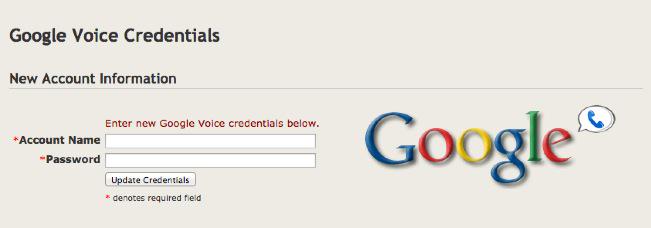
Google Voice is another little goodie that wasn’t available when Asterisk-GUI came along. Because we’re now running everything on the Asterisk 11 platform, it seemed silly not to include Google Voice support. And we’ve made it about as easy to set up as tying your shoes. Plug in your Google email address and password using the new web interface, and you’re done. By default, all 10-digit and 11-digit outbound calls are first attempted through your Google Voice trunk. You can’t beat free!
If you’ve used the same account elsewhere, Google may block access from your new IP address. In this case, just follow the steps outlined in this Google Reset Procedure to get things going.
Managing Call Detail Records (CDR) in Incredible PBX

The gorgeous CDR Viewer found under the Options -> Advanced Options -> Enable tab in Asterisk-GUI is incredibly flexible. In addition to being lightening fast, you can reorder the CDR listing by simply clicking on any column heading. Clicking twice will sort the list in the opposite order. You also can expand the detail in two ways. Either click on an individual entry (as shown) to display the complete CDR entry or check the Show All Fields checkbox to get the full picture for every CDR entry. The complete CDR database in CSV format can be retrieved from /var/log/asterisk/cdr-csv/Master.csv.
Getting Up to Speed on Asterisk-GUI Basics
We’ve covered a lot of territory this week. You don’t have to master it all at once. Incredible PBX is being engineered to give you the best of both worlds rather than one size fits all. By setting things up this way, you can add your own features and share them with the community as you move up the learning curve. That’s what open source is all about!
The other goal was to leave Asterisk-GUI intact to the greatest extent possible. This has several advantages. First, for previous users of Asterisk-GUI, they’ll feel right at home. Second, we don’t have to write extensive documentation for Asterisk-GUI because many others have already done the heavy lifting. One obvious word of caution. Don’t delete, rename, or otherwise modify the default trunks, users, calling rules, ring groups, and dialplans that already have been created to support Incredible PBX. If you do, you will break things. But feel free to add as many new pieces to your setup as desired and, of course, the extension passwords can be changed in any way you like. Trunk credentials for the "Incredible 9″ preconfigured trunks should be managed using the credentials files documented above.
Here are a few resources that will guide you through mastering the Asterisk-GUI:
- The Asterisk Appliance 50 Admin Manual (Chapter 3)
- AsteriskNOW Lab Tutorial
- MyPBX SOHO User’s Manual
- ATCOM User’s Manual
Remember the Objective of Incredible PBX for Asterisk-GUI
We’ll close for today by reiterating why we’re introducing a new VoIP alternative with Incredible PBX for Asterisk-GUI. From the ground up, this project is designed as an open source, hobbyist platform so that you can actually LEARN how Asterisk works and become self-sufficient in designing AND managing your own VoIP communications platform. Is it "Pure GUI"? Nope. Here’s why. One of the major reasons that so many folks have had their VoIP systems hacked over the past few years is because those users never quite understood how their "Pure GUI" stuff was working (or not) under the hood.
Does "hobbyist platform" mean it’s a Crappy Purple Scion? Nope. In fact, the Asterisk-GUI tools and Asterisk code in Incredible PBX were designed and written by some of the best Asterisk experts in the business including Mark Spencer, the creator of Asterisk. When the nay-sayers snicker at your "hobbyist platform," just smile and enjoy your independence. 🙂
Originally published: Monday, December 8, 2014

Need help with Asterisk? Visit the PBX in a Flash Forum.
Special Thanks to Our Generous Sponsors
FULL DISCLOSURE: ClearlyIP, Skyetel, Vitelity, DigitalOcean, Vultr, VoIP.ms, 3CX, Sangoma, TelecomsXchange and VitalPBX have provided financial support to Nerd Vittles and our open source projects through advertising, referral revenue, and/or merchandise. As an Amazon Associate and Best Buy Affiliate, we also earn from qualifying purchases. We’ve chosen these providers not the other way around. Our decisions are based upon their corporate reputation and the quality of their offerings and pricing. Our recommendations regarding technology are reached without regard to financial compensation except in situations in which comparable products at comparable pricing are available from multiple sources. In this limited case, we support our sponsors because our sponsors support us.
 BOGO Bonaza: Enjoy state-of-the-art VoIP service with a $10 credit and half-price SIP service on up to $500 of Skyetel trunking with free number porting when you fund your Skyetel account. No limits on number of simultaneous calls. Quadruple data center redundancy. $25 monthly minimum spend required. Tutorial and sign up details are here.
BOGO Bonaza: Enjoy state-of-the-art VoIP service with a $10 credit and half-price SIP service on up to $500 of Skyetel trunking with free number porting when you fund your Skyetel account. No limits on number of simultaneous calls. Quadruple data center redundancy. $25 monthly minimum spend required. Tutorial and sign up details are here.
 The lynchpin of Incredible PBX 2020 and beyond is ClearlyIP components which bring management of FreePBX modules and SIP phone integration to a level never before available with any other Asterisk distribution. And now you can configure and reconfigure your new Incredible PBX phones from the convenience of the Incredible PBX GUI.
The lynchpin of Incredible PBX 2020 and beyond is ClearlyIP components which bring management of FreePBX modules and SIP phone integration to a level never before available with any other Asterisk distribution. And now you can configure and reconfigure your new Incredible PBX phones from the convenience of the Incredible PBX GUI.
 VitalPBX is perhaps the fastest-growing PBX offering based upon Asterisk with an installed presence in more than 100 countries worldwide. VitalPBX has generously provided a customized White Label version of Incredible PBX tailored for use with all Incredible PBX and VitalPBX custom applications. Follow this link for a free test drive!
VitalPBX is perhaps the fastest-growing PBX offering based upon Asterisk with an installed presence in more than 100 countries worldwide. VitalPBX has generously provided a customized White Label version of Incredible PBX tailored for use with all Incredible PBX and VitalPBX custom applications. Follow this link for a free test drive!
 Special Thanks to Vitelity. Vitelity is now Voyant Communications and has halted new registrations for the time being. Our special thanks to Vitelity for their unwavering financial support over many years and to the many Nerd Vittles readers who continue to enjoy the benefits of their service offerings. We will keep everyone posted on further developments.
Special Thanks to Vitelity. Vitelity is now Voyant Communications and has halted new registrations for the time being. Our special thanks to Vitelity for their unwavering financial support over many years and to the many Nerd Vittles readers who continue to enjoy the benefits of their service offerings. We will keep everyone posted on further developments.
Some Recent Nerd Vittles Articles of Interest…
Incredible PBX on Steroids: The Asterisk-GUI Pilgrimage Begins (Chapter 1)

As the holiday season gets underway with Thanksgiving, Hanukkah, Christmas, and especially Festivus, we thought it might be interesting to actually provide a running dialog of how a new Asterisk® project is born and what hurdles and solutions are encountered along the way. We mentioned last week that we were dusting off Mark Spencer’s Asterisk-GUI with hopes of transforming it into an updated Asterisk 11 platform for hobbyists and SOHO telephony users with many of the ease-of-use touches that have made Incredible PBX a big hit. So today we officially kick off the adventure with a look back at Week One. Our target, by the way, is a New Year’s Day release to celebrate the arrival of 2015.
This is the first installment in our series. You can catch up with the Overview as well as Chapter 2 and Chapter 3 here.
Project Development Roadmap
You may be asking, "What’s in it for me?" Well, lots! One of the unfortunate side effects of having always relied upon the FreePBX® GUI for Asterisk administration is you never really learned how Asterisk works. Nor did we ever quite appreciate its lightning-fast performance. We’re as guilty as anyone for over-reliance on a design tool without much appreciation for its interaction with the actual communications server. And, like many things in life, you form some bad habits along the way that are hard to break. Don’t get us wrong. There are thousands of things to like about FreePBX and, for production-level servers hosting dozens or hundreds of users, it remains a very comfortable choice and our hands-down favorite.
We resolved early on to approach the Asterisk-GUI remake a little differently. We plan to actually document why we’re going down certain paths and what the benefits will be for the ultimate user. There won’t be any convoluted code to deter your learning how things actually work. And there won’t be any patent, trademark, or copyright gotchas to hinder your forking or repurposing our code to meet your own requirements. And, finally, there won’t be any license fees, hidden or otherwise. Just comply with the GPL2 license as written and be our guest! From our vantage point, that’s what open source is all about.
Defining Project Objectives
We began the week by sketching out some objectives as well as defining some likes and dislikes. As we mentioned last week, the objective is not to replace FreePBX for those that actually need that horsepower. First and foremost we want to design this product for the target audience: hobbyists, home users, and SOHO businesses. Many of the platforms we are targeting have limited memory and only modest computational ability. Many of the people in the target audience have never used a PBX before and know little to nothing about networks and security. We don’t want anyone blindsided by a $100,000 phone bill because they didn’t know how to implement a firewall so we’ll include a preconfigured one as part of the install. And, like all Incredible PBX systems, an automatic update utility will be included to keep your system current AND safe!
Second, we wanted a product that was incredibly simple to put into production. Ease of configuration was a definite must-have. With many GUIs (think: Microsoft Windows), developers get so enamored with the brilliance of their own creation that they lose sight of the fact that typing a short list of usernames and passwords often is much simpler than navigating through dozens of data entry screens with hundreds of mouse clicks to enter the same information.
We also are steering clear of reinventing the proverbial wheel. Mark Spencer and his colleagues are some of the most talented programmers on the planet. To the extent that the original, feature-rich Asterisk-GUI creation can be implemented without major plumbing changes, that is not only desirable but absolutely essential in bringing this new product to market within weeks, not months or years.
Keep in mind that both FreePBX and Asterisk-GUI are code generators for Asterisk. No call is actually processed by FreePBX or Asterisk-GUI. From a system design standpoint, we wanted Asterisk to be self-sufficient on this new Incredible PBX platform. Stated another way, we didn’t want Asterisk to fail just because Apache or MySQL had system failures since neither of them is required for Asterisk to function reliably in the first place. It’s one thing for your GUI or MySQL database to be inoperable. It’s quite another when it also brings down your entire phone system.
In summary, we are lifelong believers in the KISS principle. Keep It Simple, Stupid. As much as we love FreePBX, its system design is anything but simple. Configuration information is embedded in hundreds of HTML files, Linux templates, Asterisk configuration files including AstDB plus 100+ MySQL tables. By contrast, Asterisk-GUI uses a tiny collection of native Asterisk .conf files to configure virtually all its settings. We wanted to preserve that "pure Asterisk" simplicity.
One of the other real advantages of the Asterisk-GUI design is you can create something in the GUI and then review the Asterisk-generated code in /etc/asterisk to see exactly how the original Asterisk developers intended the feature to work. In addition to the learning experience, it makes it easy to debug coding errors and to make adjustments and customizations to meet individual needs without inadvertently bringing down the whole house of cards.
We wanted a product that was easy for an administrator to maintain, to update, AND to back up. After all, this is a phone system not a rocketship. It shouldn’t take a rocket scientist to maintain it. And it won’t.
Project Design 101: Preconfigured Trunks, Extensions & Routes

With these objectives in mind, we’ve made some design choices on the front end that are worth mentioning. Configuration settings for SIP, IAX, and Google Voice trunks give new users more headaches than any other single feature in a new PBX. So we’re taking much of the pain out of that process by providing 9 preconfigured trunks. Meet the Incredible 9: Google Voice, Vitelity, VoIP.ms, Les.net, IPcomms, DIDlogic, CallCentric, FutureNine, and Anveo Direct. Outbound calling is managed by routes that are tied to individual extensions. These can be adjusted quickly in the GUI. We’ve chosen to set up outbound calling for the Incredible 9 using preconfigured dialing prefixes. No prefix or a 1-prefix sends the call out through Google Voice and, if Google Voice isn’t available, then the call is routed through the next working outbound trunk in the order shown above. A prefix of 2-9 sends the call out through one of the preconfigured trunks. We’ve also included support for free worldwide iNum calling using either VoIP.ms or CallCentric. Both vendors will also provide you with a free iNum DID. Just dial your iNum prefix of 0 (CallCentric) or 90 (VoIP.ms) followed by the last 7 digits of any assigned iNum DID to place a free call. As usual, Lenny stands ready to provide 24/7 technical support through his iNum DID:  And, of course, all of these settings can be modified or tweaked to your liking using Asterisk-GUI!
And, of course, all of these settings can be modified or tweaked to your liking using Asterisk-GUI!
A word about the "Incredible 9″ providers. The major prerequisite for inclusion was communications compatibility with Asterisk without any firewall exposure of Asterisk ports. That means the provider had to support outbound and/or inbound calling without any port exposure of Asterisk to the Internet. Vitelity and Google have been major financial supporters of our projects over the years so they made the short list. Both also offer incredible pricing and feature-rich VoIP implementations. The others made the cut based upon great user satisfaction reports, free services of one type or another, or dirt cheap pricing. Can you add additional providers using Asterisk-GUI? Absolutely. But the "Incredible 9″ each can be activated in under 10 seconds after you’ve signed up for an account with your choice of providers. In the VoIP world, there’s little reason not to choose several since you only pay for the services you actually use, and we would encourage you to do so.
Incoming call processing also is preconfigured with some extensions, a ring group, a Stealth AutoAttendant, DISA, and an IVR with an assortment of Incredible PBX applications for Asterisk. All can be modified or embellished to meet your own requirements.
Bottom Line: You get a turnkey PBX that’s ready to go. It’s also easily configurable to meet your most demanding requirements. Incredible PBX delivers The Best of Both Worlds using native Asterisk code.
A Fresh Look at Managing Credentials
One of the more exasperating realities of password management with FreePBX is the number of places you have to look to find or change passwords. Some are stored in various Asterisk .conf files. Voicemail passwords are hidden away in text strings in voicemail.conf. Others are stored in MySQL tables. Some are encrypted, and some aren’t. Asterisk-GUI took a different approach and stores all passwords in the Asterisk .conf files in /etc/asterisk.
As talented as the FreePBX and Asterisk-GUI programmers are, we don’t trust any web-based application to remain secure if it’s directly exposed to the Internet. If you do, you’re either nuts or have plenty of money to burn. GUIs should be reserved for administrator use behind a secure firewall, period. In our new design, you need firewall whitelist privileges plus root or asterisk user privileges plus GUI admin user access to gain access to passwords. If all of these layers are compromised, passwords are the least of your worries.
We’ve taken password management one step further. As best we can given the design choices in Asterisk 11 and Asterisk-GUI, we’ve aggregated as many passwords as possible into new credentials config files: credentials-sip.conf, credentials-googlevoice.conf, and credentials-extensions.conf. There’s one for the "Incredible 9″ SIP providers. There’s one for Google Voice. And there’s a catchall for various passwords, PINs, and predefined CallerID numbers for various trunks. These are straight-forward text files that can be quickly edited using any text editor. Plug in your account names, passwords, and PINs. Optionally, adjust the providers’ server addresses as required. And you’re done. If you can tie your shoes, you can do this. Quick and functional, not fancy!
Redesigned Conferencing Solution for Asterisk 11
MeetMe conferencing as originally implemented in Asterisk-GUI required an external timing source. This timing source was provided by analog boards on some of the commercial hardware platforms on which Asterisk-GUI was deployed. For our target audience, we’re assuming that most people probably want to ditch Ma Bell and costly landlines as part of the migration to a new PBX platform. So, even though Asterisk-GUI still supports analog trunks, we have chosen to offer the Asterisk 11 Conference Bridge option which does not require an external timing source. The new Conference Bridge is preconfigured out of the box. Set up user and admin PINs. And you’re done. Dial C-O-N-F (3663) to join the conference.
The Baker’s Dozen Incredible PBX Apps: Alive and Well
We closed out Week One with some minor tweaking of several of our favorite Incredible PBX applications to accommodate the new Asterisk-GUI platform. We’re pleased to report that everything still works. Because of changes imposed by Google, you’ll need to jump through a few hoops to implement Speech Recognition support on this new Asterisk platform. All of the necessary software has already been put in place so all you need is an API key from Google. Once you obtain it, simply plug it into line 70 of speech-recog.agi. No other configuration is required. The affected applications are marked with an asterisk (*) below. But the good news is, if you’ve used these Nerd Vittles applications in the past, you’ll feel right at home.
Stay tuned for more and… HAPPY THANKSGIVING!
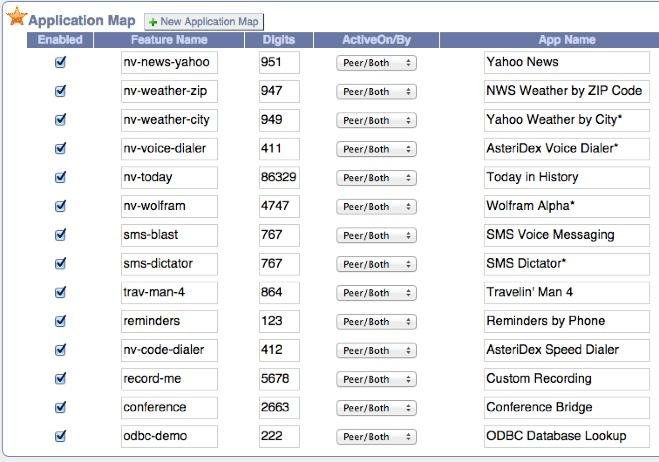
Originally published: Monday, November 24, 2014

Need help with Asterisk? Visit the PBX in a Flash Forum.
Special Thanks to Our Generous Sponsors
FULL DISCLOSURE: ClearlyIP, Skyetel, Vitelity, DigitalOcean, Vultr, VoIP.ms, 3CX, Sangoma, TelecomsXchange and VitalPBX have provided financial support to Nerd Vittles and our open source projects through advertising, referral revenue, and/or merchandise. As an Amazon Associate and Best Buy Affiliate, we also earn from qualifying purchases. We’ve chosen these providers not the other way around. Our decisions are based upon their corporate reputation and the quality of their offerings and pricing. Our recommendations regarding technology are reached without regard to financial compensation except in situations in which comparable products at comparable pricing are available from multiple sources. In this limited case, we support our sponsors because our sponsors support us.
 BOGO Bonaza: Enjoy state-of-the-art VoIP service with a $10 credit and half-price SIP service on up to $500 of Skyetel trunking with free number porting when you fund your Skyetel account. No limits on number of simultaneous calls. Quadruple data center redundancy. $25 monthly minimum spend required. Tutorial and sign up details are here.
BOGO Bonaza: Enjoy state-of-the-art VoIP service with a $10 credit and half-price SIP service on up to $500 of Skyetel trunking with free number porting when you fund your Skyetel account. No limits on number of simultaneous calls. Quadruple data center redundancy. $25 monthly minimum spend required. Tutorial and sign up details are here.
 The lynchpin of Incredible PBX 2020 and beyond is ClearlyIP components which bring management of FreePBX modules and SIP phone integration to a level never before available with any other Asterisk distribution. And now you can configure and reconfigure your new Incredible PBX phones from the convenience of the Incredible PBX GUI.
The lynchpin of Incredible PBX 2020 and beyond is ClearlyIP components which bring management of FreePBX modules and SIP phone integration to a level never before available with any other Asterisk distribution. And now you can configure and reconfigure your new Incredible PBX phones from the convenience of the Incredible PBX GUI.
 VitalPBX is perhaps the fastest-growing PBX offering based upon Asterisk with an installed presence in more than 100 countries worldwide. VitalPBX has generously provided a customized White Label version of Incredible PBX tailored for use with all Incredible PBX and VitalPBX custom applications. Follow this link for a free test drive!
VitalPBX is perhaps the fastest-growing PBX offering based upon Asterisk with an installed presence in more than 100 countries worldwide. VitalPBX has generously provided a customized White Label version of Incredible PBX tailored for use with all Incredible PBX and VitalPBX custom applications. Follow this link for a free test drive!
 Special Thanks to Vitelity. Vitelity is now Voyant Communications and has halted new registrations for the time being. Our special thanks to Vitelity for their unwavering financial support over many years and to the many Nerd Vittles readers who continue to enjoy the benefits of their service offerings. We will keep everyone posted on further developments.
Special Thanks to Vitelity. Vitelity is now Voyant Communications and has halted new registrations for the time being. Our special thanks to Vitelity for their unwavering financial support over many years and to the many Nerd Vittles readers who continue to enjoy the benefits of their service offerings. We will keep everyone posted on further developments.
Some Recent Nerd Vittles Articles of Interest…
A Firsthand Look at Disaster Recovery: Tethering and IAX with Asterisk

One of the exciting challenges of building a swimming pool is knowing that it’s just a matter of time until your Internet connection dies. As you might imagine, swimming pools are major construction and involve a lot of digging. And digging usually means some oops moments when cables get cut. In our case, we had watched the folks digging the trenches for all of the pool plumbing to be sure they didn’t accidentally whack one of three coax cables coming into our house. And, when it came time to cover up the trenches, we pointed out the orange cables to the Bobcat driver knowing we were finally home free. Not so fast! Two minutes later, Mario had driven the Bobcat right over the primary Internet cable leaving the shredded remains sticking up through the dirt. Oops. Sorry. Shit happens!
Looking on the positive side, we chuckled, "What a perfect opportunity to test our backup Asterisk® system!" Our backup system is pretty clever if we do say so. It relies upon a Verizon WiFi HotSpot running on our Galaxy smartphone and a duplicate of our Asterisk-based PBX in a Flash™ server running as a virtual machine under VirtualBox on an iMac desktop. The entire setup takes less than a minute to activate. Well, that was the plan anyway.
It turns out that Verizon does SIP a little differently with a SIP ALG in the path so Asterisk couldn’t register with all but one of our dozen SIP providers. Congratulations, CallCentric! The workaround is to enable STUN. That is now possible with Asterisk 11. Short of that, you’re left with CallCentric. Unfortunately for us, we don’t do much SIP trunking with CallCentric, and none of our primary DIDs are connected through them. The other option is to add port=5080 to your trunk setup with any SIP trunks you register with VoIP.ms using a username and password. Our attention span was too short to tackle STUN in the middle of this crisis. But there’s good news. Verizon doesn’t mess with IAX network traffic at all. Since a couple of our primary DIDs are registered with VoIP.ms using IAX trunks, restoring these IAX trunks to full functionality took less than a minute. That is step one of a three-step process. You need inbound trunks, phones, and outbound trunks to get your redundant VoIP server back in business.
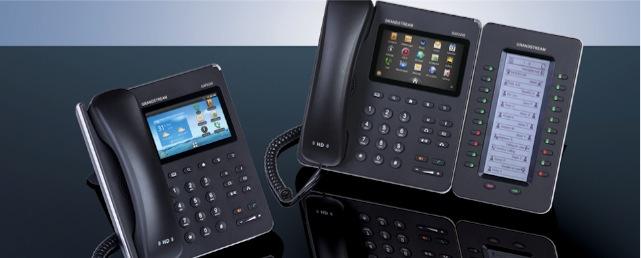
Getting phones to function on what is now a purely WiFi network (through the Verizon HotSpot) can be problematic unless you’ve done your homework and sprinkled a few WiFi-capable SIP phones around your home or office. In our case, we still have Grandstream’s GXP2200 Android phones scattered everywhere so it was just a matter of plugging in the WiFI adapters and rebooting. The newer GXV3240 would work just as well.1
All that remained was enabling several trunks for outbound calls. Since VoIP.ms IAX trunks support both incoming and outgoing calls, we were home free. And, with Google Voice trunks, it was simply a matter of jumping through Google’s security hoops to reenable the connections on a new IP address.
Lessons Learned. Here’s a quick checklist for those of you that think about disaster recovery for your home or for clients and businesses. Nothing beats some advance planning. If money is no object, then WiFi tethering from a smartphone with one of the major providers whose service works well in your home or office environment is the way to go. 4G is a must!
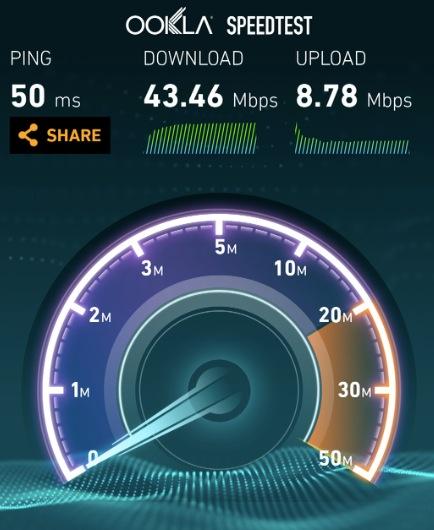
In our case, money was an object so we had the foresight to acquire a Verizon SIM card from eBay that included an unlimited data plan. With this setup, it costs only $1 a day extra to add WiFi tethering, and you can turn it off and on as often as you like without any additional fees or surcharges. There also are no additional charges for using boatloads of data! We’re actually writing this column with a tethered connection from a hotel in Washington (results above). To give you some idea of why an unlimited data plan is important, our home operation burned through 4 gigs of data in less than 24 hours once we activated WiFi tethering. Of course, there were people doing things other than making phones calls, but tethering enables 5 connections to function just about like the cable modem service you originally had in place. So expect the data usage to be substantial. Everybody likes 24/7 Internet service.
Loss of phone calls through a PBX is more of an annoyance than a crisis these days because almost everyone also has a smartphone. Even so, the SIP gotcha with Verizon Wireless was a surprise because we hadn’t really tested our super-duper emergency system in advance. That wasn’t too smart obviously. The old adage applies. Do as we say, not as we do. Unplug your cable modem or DSL connection and actually test your backup system before D-Day arrives.
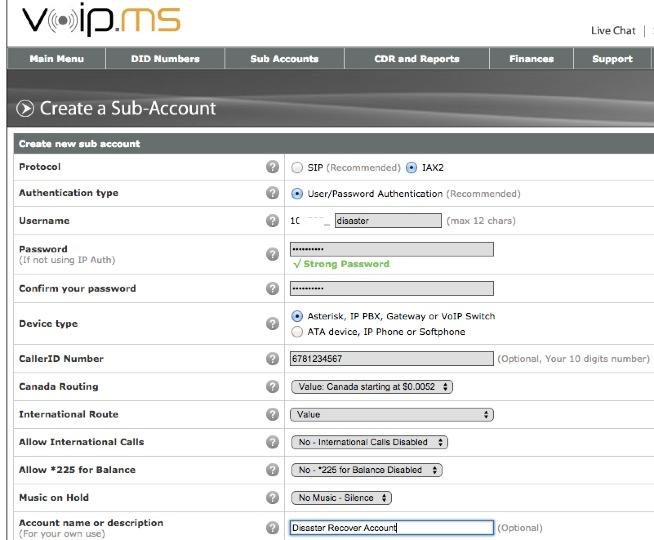
On the VoIP provider end, now is the time to set up an account with a provider that offers both SIP and IAX connectivity. Step 2 is to actually configure an IAX trunk (as a subaccount to use VoIP.ms parlance) and test it. IAX trunks actually have fewer headaches with NAT, but there are only a handful of providers that still provide the service. Find one now and make certain that your primary DIDs will roll over to the IAX trunk in case of an outage. I’m always reminded that we have Mark Spencer to thank for IAX. It was his brainchild. Thank you, Mark! With VoIP.ms, you also can spoof your CallerID so that calls will still appear to originate from your primary Asterisk PBX.
Keep in mind that a VirtualBox-based Asterisk virtual machine and a Desktop computer both need an IP address and will have to be started on WLAN0 rather than ETH0. Remember, your wired connection is now dead.
You’re also going to want to acquire at least a couple of WiFi-capable SIP phones that can be connected with your Asterisk server using your WiFi HotSpot. Also make certain that you have a preconfigured IPtables firewall on your backup system. Remember, your hardware-based firewall connected to your cable modem won’t provide any protection once you switch to HotSpot operation. Lucky for you, Incredible PBX™ servers come preconfigured with a locked-down IPtables firewall and a WhiteList. Just add the new IP addresses of your server and phones, and you’re secure on the public Internet.
Finally, let’s do the HotSpot connection math. You’ll need an IP address for your desktop computer running VirtualBox. You’ll need a second IP address for the Asterisk virtual machine. Then you’ll need an IP address for every WiFi-enabled SIP phone. If the maximum number of connections is five on your HotSpot, that means you’ve got the necessary capacity for at most 3 WiFi SIP phones assuming you don’t enable a WiFi printer and if nobody else wants to use a computer during the outage. The other option is to add an inexpensive travel router with bridge mode to your mix of 5 devices. We always keep one handy for extended trips. A properly configured travel router provides an additional WiFi network with some extra WiFi connections. Good luck!
Security Alerts. Serious SSL and FreePBX security vulnerabilities have been discovered AND patched during the past week. If you have not patched your server and Asterisk, FreePBX, Apache, and/or WebMin are exposed to the public Internet, you have a serious problem on your hands. See this thread for details on the FreePBX vulnerability. And see this thread for the steps necessary to patch SSL in Asterisk, Apache, and Webmin. While Incredible PBX servers were automatically patched for the FreePBX vulnerability, the SSL issues require manual patching and an Asterisk upgrade. A script for upgrading Asterisk 11 servers is included in the message thread linked above. ALWAYS run your VoIP server behind a firewall with no Internet port exposure to Asterisk, FreePBX, SSH, or the Apache and Webmin web servers! And, if you think all of this security stuff is just a silly waste of your time, then read about the latest lucky recipient of a $166,000 phone bill.
Originally published: Monday, October 20, 2014

Need help with Asterisk? Visit the PBX in a Flash Forum.
Special Thanks to Our Generous Sponsors
FULL DISCLOSURE: ClearlyIP, Skyetel, Vitelity, DigitalOcean, Vultr, VoIP.ms, 3CX, Sangoma, TelecomsXchange and VitalPBX have provided financial support to Nerd Vittles and our open source projects through advertising, referral revenue, and/or merchandise. As an Amazon Associate and Best Buy Affiliate, we also earn from qualifying purchases. We’ve chosen these providers not the other way around. Our decisions are based upon their corporate reputation and the quality of their offerings and pricing. Our recommendations regarding technology are reached without regard to financial compensation except in situations in which comparable products at comparable pricing are available from multiple sources. In this limited case, we support our sponsors because our sponsors support us.
 BOGO Bonaza: Enjoy state-of-the-art VoIP service with a $10 credit and half-price SIP service on up to $500 of Skyetel trunking with free number porting when you fund your Skyetel account. No limits on number of simultaneous calls. Quadruple data center redundancy. $25 monthly minimum spend required. Tutorial and sign up details are here.
BOGO Bonaza: Enjoy state-of-the-art VoIP service with a $10 credit and half-price SIP service on up to $500 of Skyetel trunking with free number porting when you fund your Skyetel account. No limits on number of simultaneous calls. Quadruple data center redundancy. $25 monthly minimum spend required. Tutorial and sign up details are here.
 The lynchpin of Incredible PBX 2020 and beyond is ClearlyIP components which bring management of FreePBX modules and SIP phone integration to a level never before available with any other Asterisk distribution. And now you can configure and reconfigure your new Incredible PBX phones from the convenience of the Incredible PBX GUI.
The lynchpin of Incredible PBX 2020 and beyond is ClearlyIP components which bring management of FreePBX modules and SIP phone integration to a level never before available with any other Asterisk distribution. And now you can configure and reconfigure your new Incredible PBX phones from the convenience of the Incredible PBX GUI.
 VitalPBX is perhaps the fastest-growing PBX offering based upon Asterisk with an installed presence in more than 100 countries worldwide. VitalPBX has generously provided a customized White Label version of Incredible PBX tailored for use with all Incredible PBX and VitalPBX custom applications. Follow this link for a free test drive!
VitalPBX is perhaps the fastest-growing PBX offering based upon Asterisk with an installed presence in more than 100 countries worldwide. VitalPBX has generously provided a customized White Label version of Incredible PBX tailored for use with all Incredible PBX and VitalPBX custom applications. Follow this link for a free test drive!
 Special Thanks to Vitelity. Vitelity is now Voyant Communications and has halted new registrations for the time being. Our special thanks to Vitelity for their unwavering financial support over many years and to the many Nerd Vittles readers who continue to enjoy the benefits of their service offerings. We will keep everyone posted on further developments.
Special Thanks to Vitelity. Vitelity is now Voyant Communications and has halted new registrations for the time being. Our special thanks to Vitelity for their unwavering financial support over many years and to the many Nerd Vittles readers who continue to enjoy the benefits of their service offerings. We will keep everyone posted on further developments.
Some Recent Nerd Vittles Articles of Interest…
- Some of our links refer users to Amazon or other service providers when we find their prices are competitive for the recommended products. Nerd Vittles receives a small referral fee from these providers to help cover the costs of our blog. We never recommend particular products solely to generate commissions. However, when pricing is comparable or availability is favorable, we support these providers because they support us. [↩]
The 5-Minute PBX: A Fresh Look at Oracle’s VirtualBox with Incredible PBX
Today we’re paying another visit to our favorite virtual machine platform and introducing four new VoIP images that let you compare features and performance of Asterisk® 11 running atop Ubuntu® 14 or Scientific Linux™ 6.5 with FreePBX® 2.11 or the just-released version 12 release candidate. Think of Incredible PBX™ as the VoIP glue stick that assembles all the necessary VoIP components and holds them together seamlessly. As with all Incredible PBX builds, you also get the full complement of goodies including dozens of text-to-speech apps, voice dialing, SMS messaging, fax support, reminders and wakeup calls, and SECURITY! The difference with the VirtualBox® platform is you get a turnkey install of everything on any desktop computer in less than 5 minutes! That includes Windows PCs, Macs, Linux desktops, and even Solaris machines.

Is VirtualBox merely a sandbox for experimentation? Absolutely not. With any of the beefier desktop computers available today, running Incredible PBX as a 24/7 VirtualBox image is every bit as feature rich with stellar performance that’s equivalent to using dedicated hardware. And there are some added advantages. Obviously, deploying a turnkey VoIP platform in under 5 minutes is a major plus. But, unlike using a dedicated Linux platform, you also get the ability to take snapshots of your system and do full backups in minutes instead of the hours required to bring down dedicated hardware, load a different backup application using a different operating system, perform a backup, and then reboot your VoIP server. And your backups won’t just run on the one server on which the backup was performed. You can restore the backup to any other computer that can run VirtualBox. For any of you that came from a network management background, you know what a big deal that really is. And there’s one more bonus. With Incredible Backup and Restore, you can move your image to dedicated hardware running the same operating system with Asterisk 11 and the same version of FreePBX in minutes.
Need to deploy VoIP servers at dozens of sites around the globe? Not a problem with VirtualBox. Just send a preconfigured VirtualBox image to each site and install VirtualBox on a local desktop computer. In 5 minutes, you have a functional VoIP server including interconnectivity to all of your other VoIP servers with a virtual private network already in place to provide secure VoIP connectivity between all of your sites.
Are there security compromises using the VirtualBox platform? Not at all. Incredible PBX still comes preconfigured with the Linux IPtables firewall that is locked down to a whitelist of local area networks, preferred providers, and your own IP addresses. You can expand the whitelist using the add-ip and add-fqdn scripts or use PortKnocker and Travelin’ Man 4 tools to let remote users gain instant access.
Why four different Incredible PBX images? Glad you asked. Ubuntu and Scientific Linux are a bit like French and Spanish. They’re both languages for communicating, but many of the words are different. Some prefer one or the other so now you have a choice. As for the FreePBX options, let us put in a plug for the FreePBX 12 release candidate. The FreePBX Dev Team has invested thousands of hours in this new software. It shows! Please take it for a spin and give the developers some feedback. To move to Asterisk 12 and 13, you’re going to need FreePBX 12 so you might as well start getting used to it. While there are many similarities in the user interface, the under-the-covers work that the FreePBX team has invested in this new product is nothing short of amazing. There’s very little of the FreePBX 2.11 code that hasn’t been either cleaned up or completely rewritten. We think you’ll like it so give it a try. Those that need a production environment probably should stick with FreePBX 2.11 for the time being. The new Virtual Box images also give you an opportunity to compare performance between the two operating systems and the two FreePBX versions. This isn’t 1999. Take advantage of the opportunity. It only takes a few minutes to spin up a new virtual machine and go for a test drive.
Getting Started. For today, we’ll provide a refresher course on loading VirtualBox and one of the Incredible PBX virtual images. Then we want to spend a little time explaining the secret sauce that goes into building these images so that you can do it yourself either to migrate to a different network or to deploy at multiple sites. When we’re finished, you’ll know everything we’ve learned about deploying VirtualBox machines and, unlike Grandma, we won’t leave an important ingredient out of the recipe just to be sure you never forget how good Grandma’s cookies really were. So let’s get started.
Installing Oracle VM VirtualBox

Oracle’s virtual machine platform inherited from Sun is amazing. It’s not only free, but it’s pure GPL2 code. VirtualBox gives you a virtual machine platform that runs on top of any desktop operating system. In terms of limitations, we haven’t found any. We even tested this on an Atom-based Windows 7 machine with 2GB of RAM, and it worked without a hiccup. So step #1 today is to download one or more of the VirtualBox installers from VirtualBox.org or Oracle.com. Our recommendation is to put all of the 100MB installers on a 4GB thumb drive.1 Then you’ll have everything in one place whenever and wherever you happen to need it. Once you’ve downloaded the software, simply install it onto your favorite desktop machine. Accept all of the default settings, and you’ll be good to go. For more details, here’s a link to the Oracle VM VirtualBox User Manual.
Downloading the Incredible PBX Virtual Machines
A word of warning on the front end. Incredible PBX images featuring Asterisk 11 for VirtualBox are huge! The two Ubuntu images for FreePBX 2.11 and 12 are 1.5GB. The two Scientific Linux 6.5 images for FreePBX 2.11 and 12 are 2.3GB. We’ve added SourceForge hotlinks. So simply click on the desired images and download them to your desktop. Then go to lunch.
Importing & Configuring Incredible PBX Virtual Machines in VirtualBox
You only perform the import step one time. Once imported into VirtualBox, Incredible PBX is ready to use. There’s no further installation required, just like an OpenVZ template… only better. Double-click on the .ova file you downloaded to begin the procedure and load it into VirtualBox. When prompted, be sure to check the Reinitialize the Mac address of all network cards box and then click the Import button. Once the import is finished, you’ll see a new Incredible PBX virtual machine in your VM List on the VirtualBox Manager Window. We need to make a couple of one-time adjustments to the Incredible PBX VM configuration to account for differences in sound and network cards on different host machines.
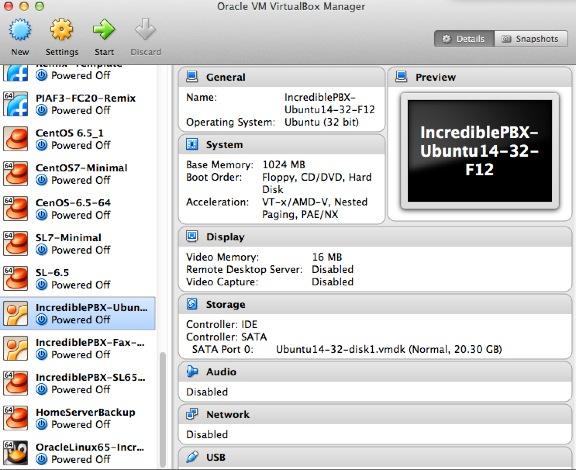
Click on the Incredible PBX Virtual Machine in the VM List. Then click Settings -> Audio and check the Enable Audio option and choose your sound card. Save your setup by clicking the OK button. Next click Settings -> Network. For Adapter 1, check the Enable Network Adapter option. From the Attached to pull-down menu, choose Bridged Adapter. Then select your network card from the Name list. Then click OK. Finally, click Settings -> System, uncheck Hardware clock in UTC time, and click OK. That’s all the configuration that is necessary for your Incredible PBX Virtual Machine. The rest is automagic.
Running Incredible PBX Virtual Machines in VirtualBox
Once you’ve imported and configured the Incredible PBX Virtual Machine, you’re ready to go. Highlight IncrediblePBX Virtual Machine in the VM List on the VirtualBox Manager Window and click the Start button. The boot procedure with your chosen operating system will begin just as if you had installed Incredible PBX on a standalone machine. You’ll see a couple of dialogue boxes pop up that explain the keystrokes to move back and forth between your host operating system desktop and your virtual machine. Remember, you still have full access to your desktop computer. Incredible PBX is merely running as a task in a VirtualBox window. Always gracefully halt Incredible PBX just as you would on a dedicated computer.
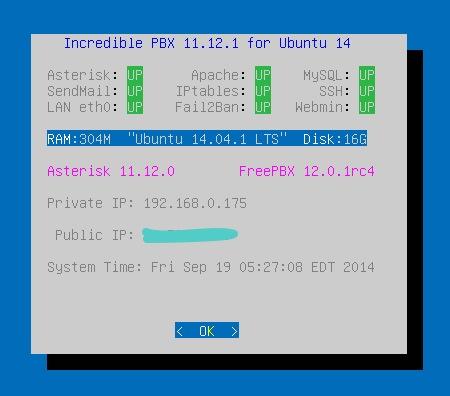
Here’s what you need to know. To work in the Incredible PBX Virtual Machine, just left-click your mouse while it is positioned inside the VM window. To return to your host operating system desktop, press the right Option key on Windows machines or the left Command key on any Mac. For other operating systems, read the dialogue boxes for instructions on moving around. To access the Linux CLI, login as root with the default password: password. To access FreePBX with a browser, point to the IP address of your virtual machine and login as admin with admin password set below. For the security of your server, we recommend that you log in to the Linux CLI at least once a week so that Incredible PBX updates get applied to your server regularly. This is critically important if you care about your phone bill.
When logging in for the first time, Incredible PBX will go through some setup steps and then reboot. Login again to complete the setup. status will always provide a snapshot of your system. To shut down Incredible PBX gracefully, click in the VM window with your mouse, log in as root, and type: halt. Be sure to complete the following setup steps from the Linux CLI:
- Change your root password: passwd
- Set your FreePBX admin password: /root/admin-pw-change
- Set your correct time zone: /root/timezone-setup
- Add WhiteList entries to firewall if needed: /root/add-ip or /root/add-fqdn
- Store PortKnocker credentials in a safe place: cat /root/knock.FAQ
- Enable SAMBA if desired: /root/samba-enable.sh
- Enable Incredible Fax support if desired: (script in /root)
- Login to your NeoRouter VPN server if desired: /root/nrclientcmd
Preparing Incredible PBX Virtual Machines for Migration
As the Linux operating systems have become more turnkey, one of the shortcuts that has been implemented on both the RedHat and Debian/Ubuntu platforms is storage of your network setup so that the server reboots more quickly. While that’s fine for rebooting on the same server, it’s a real problem if you attempt to move your setup to different hardware or a new network because eth0 will not load. That means no IP address! Here are two ways to assure that things will actually work after the move. Both assume that you will have a DHCP server at the new location just as you did at your existing site.
The Easy Way. If you have console access after the VM image is restored on the new platform (which means you don’t need a network IP address for the server in order to log in as root), then the easy way to prepare any of the Incredible PBX machines for relocation is to issue the following commands before you halt the system and make a VirtualBox backup:
touch /etc/update_hostconfig touch /etc/update_serverconfig
Once you have halted the server, edit both the sound card and network card settings and disable both of them in VirtualBox Manager. Then choose File -> Export Appliance from the VirtualBox title bar and create a .ova backup image on your desktop. You now have an image that is similar to the Incredible PBX image that you originally downloaded, except it has all of your data and settings. All you have to do is repeat the install drill above at the new location using the .ova image you created and log in with whatever your current root password happens to be. You’ll get a two-pass automatic setup just as you did when you began today’s adventure.
The only drawback to this procedure is the fact that the extension 701 and default DISA passwords will be initialized when you first boot from your .ova image at the other location. Aside from that, you’ll have a clean platform with new SSH and DUNDI credentials as well as mostly sanitized log files.
The Hard Way. The other alternative is to manually prepare your existing system for migration before you shut it down. The primary reason for doing this would be to assure that you can log in with an SSH client at the other end as soon as the server is booted. The steps differ a bit depending upon whether you’re on the Ubuntu or Scientific Linux platform. But on both platforms you need to enter the IP address from which you will log in at the new site unless it is on one of the private LAN subnets that already is whitelisted in IPtables. Just issue the command /root/add-ip and choose 0 option to enable all services for the new IP address. Then…
On the Ubuntu platform, issue the following commands:
touch /etc/update_hostconfig touch /etc/update_serverconfig rm -f /var/lib/dhcp/* rm -f /etc/udev/rules.d/70* halt
On the Scientific Linux platform, issue the following commands:
touch /etc/update_hostconfig touch /etc/update_serverconfig rm -f /var/lib/dhcpd/* rm -f /var/lib/dhclient/* rm -f /etc/udev/rules.d/70* halt
Once you have halted the server, edit both the sound card and network card settings and disable both of them in VirtualBox Manager. Then choose File -> Export Appliance from the VirtualBox title bar and create a .ova backup image on your desktop. Now you’re an expert. Enjoy!
Originally published: Monday, September 22, 2014
 Support Issues. With any application as sophisticated as this one, you’re bound to have questions. Blog comments are a terrible place to handle support issues although we welcome general comments about our articles and software. If you have particular support issues, we encourage you to get actively involved in the PBX in a Flash Forums. It’s the best Asterisk tech support site in the business, and it’s all free! Please have a look and post your support questions there. Our forum is extremely friendly and is supported by literally hundreds of Asterisk gurus.
Support Issues. With any application as sophisticated as this one, you’re bound to have questions. Blog comments are a terrible place to handle support issues although we welcome general comments about our articles and software. If you have particular support issues, we encourage you to get actively involved in the PBX in a Flash Forums. It’s the best Asterisk tech support site in the business, and it’s all free! Please have a look and post your support questions there. Our forum is extremely friendly and is supported by literally hundreds of Asterisk gurus.

Need help with Asterisk? Visit the PBX in a Flash Forum.
Special Thanks to Our Generous Sponsors
FULL DISCLOSURE: ClearlyIP, Skyetel, Vitelity, DigitalOcean, Vultr, VoIP.ms, 3CX, Sangoma, TelecomsXchange and VitalPBX have provided financial support to Nerd Vittles and our open source projects through advertising, referral revenue, and/or merchandise. As an Amazon Associate and Best Buy Affiliate, we also earn from qualifying purchases. We’ve chosen these providers not the other way around. Our decisions are based upon their corporate reputation and the quality of their offerings and pricing. Our recommendations regarding technology are reached without regard to financial compensation except in situations in which comparable products at comparable pricing are available from multiple sources. In this limited case, we support our sponsors because our sponsors support us.
 BOGO Bonaza: Enjoy state-of-the-art VoIP service with a $10 credit and half-price SIP service on up to $500 of Skyetel trunking with free number porting when you fund your Skyetel account. No limits on number of simultaneous calls. Quadruple data center redundancy. $25 monthly minimum spend required. Tutorial and sign up details are here.
BOGO Bonaza: Enjoy state-of-the-art VoIP service with a $10 credit and half-price SIP service on up to $500 of Skyetel trunking with free number porting when you fund your Skyetel account. No limits on number of simultaneous calls. Quadruple data center redundancy. $25 monthly minimum spend required. Tutorial and sign up details are here.
 The lynchpin of Incredible PBX 2020 and beyond is ClearlyIP components which bring management of FreePBX modules and SIP phone integration to a level never before available with any other Asterisk distribution. And now you can configure and reconfigure your new Incredible PBX phones from the convenience of the Incredible PBX GUI.
The lynchpin of Incredible PBX 2020 and beyond is ClearlyIP components which bring management of FreePBX modules and SIP phone integration to a level never before available with any other Asterisk distribution. And now you can configure and reconfigure your new Incredible PBX phones from the convenience of the Incredible PBX GUI.
 VitalPBX is perhaps the fastest-growing PBX offering based upon Asterisk with an installed presence in more than 100 countries worldwide. VitalPBX has generously provided a customized White Label version of Incredible PBX tailored for use with all Incredible PBX and VitalPBX custom applications. Follow this link for a free test drive!
VitalPBX is perhaps the fastest-growing PBX offering based upon Asterisk with an installed presence in more than 100 countries worldwide. VitalPBX has generously provided a customized White Label version of Incredible PBX tailored for use with all Incredible PBX and VitalPBX custom applications. Follow this link for a free test drive!
 Special Thanks to Vitelity. Vitelity is now Voyant Communications and has halted new registrations for the time being. Our special thanks to Vitelity for their unwavering financial support over many years and to the many Nerd Vittles readers who continue to enjoy the benefits of their service offerings. We will keep everyone posted on further developments.
Special Thanks to Vitelity. Vitelity is now Voyant Communications and has halted new registrations for the time being. Our special thanks to Vitelity for their unwavering financial support over many years and to the many Nerd Vittles readers who continue to enjoy the benefits of their service offerings. We will keep everyone posted on further developments.
Some Recent Nerd Vittles Articles of Interest…
- Many of our purchase links refer users to Amazon when we find their prices are competitive for the recommended products. Nerd Vittles receives a small referral fee from Amazon to help cover the costs of our blog. We never recommend particular products solely to generate Amazon commissions. However, when pricing is comparable or availability is favorable, we support Amazon because Amazon supports us. [↩]
VoIP Hardware Deal of the Year: Meet the $20 Pogoplug 4 with Incredible PBX

This week’s project is not for mere mortals. It’s for techies that also happen to be cheapskates frugal. You may recall the Pogoplug from yesteryear. Well, the Pogoplug 4 still is around and can be yours for under $20 with free 2-day shipping if you’re an Amazon Prime member. But the clock is ticking on these bad boys. Once they’re gone, they’re gone.1
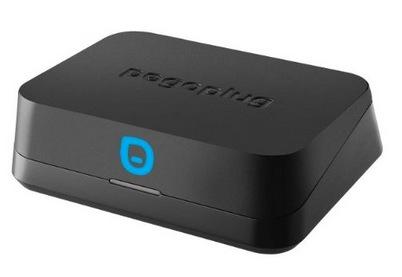
UPDATE: There’s more good news. Now the cost with the Pogoplug Backup & Sharing model is just $10.95! For our purposes, the main difference is one less USB port, but it still has one which is all you need for wireless networking.
So we took the dare and decided to see whether the Pogoplug 4 could actually run Asterisk 11® and FreePBX® 2.11 and Incredible PBX™. And guess what? It may not be pretty, but it works. If you happen to have a Google Voice number and a kid away at school or a grandma in a distant city with an Internet connection or if you have a vacation home or rental property that needs phone service (but not often), then this $20 project may be for you. Configure the device, add a cheap SIP phone, and presto! You’ve got free calling in the U.S. and Canada with your very own phone number for as long as you have Internet service and Google chooses to keep paying your phone bill. 😉
Don’t take our word for it. Call our Pogoplug for a quick IVR demo compliments of Allison: 
- Call by Name (just say "American Airlines" to try it out)
- Conference Call (enter 1234# to join the conference)
- Wolfram Alpha (try this: "What planes are overhead?")
- Lenny (the Telemarketers’ Worst Nightmare)
- Yahoo News Headlines
- Weather Forecasts (say a city and state or country)
- Today in History
- Ring the House Phones (sends you back to Lenny)
Our tip of the hat this week goes to Qui Hong without whom none of this would have been possible. His tutorial on transforming the Pogoplug 4 into a Debian server is a true masterpiece. And his blog is where we begin our adventure once you have the correct Pogoplug 4 in hand: POGO-V4-A3-01. Our link has the correct one, but double-check the Model Number just to be sure.
Converting the Pogoplug 4 into a Debian Platform
Once you have your Pogoplug, you’ll need to scurry over to Qui Hong’s blog and carefully work through his tutorial to convert your Pogoplug into a Debian server. As we’ve said many times before, if you can follow a cookie recipe and end up with edible cookies, then you can do this. Just be very careful of typos. One bad keystroke can turn your Pogoplug into a burnt cookie. Then it becomes a $40 project. 🙂
Installing Incredible PBX 11.12.0 on the Pogoplug 4
Once your Pogoplug has been Debianized, there are five simple steps to get Incredible PBX up and running on your Pogoplug 4:
- Purchase a storage device
- Download Incredible PBX image
- Untar the image on your desktop
- Burn the image to an SD card
- Insert the SD card in the Pogoplug and boot
Choosing a Storage Platform. The first step is to purchase a suitable SD card. We recommend at least a 16GB Class 10 card from Transcend, SanDisk, or Kingston. All of them are about $10 on Amazon and many include free 2-day shipping for Prime customers.
Downloading Incredible PBX for Pogoplug. From your favorite desktop computer, download the latest build of Incredible PBX from SourceForge. Depending upon your network connection and the SourceForge mirror, it can take awhile. It’s a whopping 1.5GB image!
Untarring Incredible PBX for Pogoplug. Depending upon your desktop platform, untarring incrediblepbx.4.pogoplug.D7.latest.tar.gz is as simple as double-clicking on it in the Downloads folder (on a Mac). On the Windows platform, here are 3 utilities that will do the job. On a Linux desktop, open a Terminal window and…
tar zxvf incrediblepbx.4.pogoplug.D7.latest.tar.gz
Burning the Incredible PBX image to SD card. Once you’ve untarred the file, you’ll find two scripts that make burning the image to an SD card simple if you’re on a Mac or Linux desktop. On a Windows machine, it’s a little more complicated. Most SD cards come preformatted with a DOS partition so your Windows machine should recognize the SD card when it’s inserted. If not, format the card using a utility such as SD Card Formatter. Next, you’ll need Win32 Disk Imager to burn pogoplug.img to your card. Once the image has been transferred, gracefully unmount the card from your desktop.
Booting Incredible PBX on the Pogoplug. Insert the SD card (electronics side down) into your Pogoplug 4. Then apply power to the device after connecting an Ethernet cable to a network with Internet connectivity that can also hand out DHCP addresses. Visit your router to decipher the IP address assigned to the Pogoplug and reserve the IP address so that it doesn’t suddenly change down the road. Log into Incredible PBX as root with pogoplug as your password. Your SSH credentials, Asterisk DUNDI secrets, logs, and network connection options will be initialized. When prompted, press Enter to reboot your server. With some SD cards, you may find yourself waiting an eternity for the promised reboot. After seeing the "rebooting" message, count to ten. If your server still hasn’t rebooted, remove and reapply power. This quirk goes away after the first reboot.
After the reboot, log in again as root with password: pogoplug. Your firewall setup will be initialized to lock down your whitelist to your server’s public and private IP addresses AND the IP address of the machine from which you’re logging in. All of your FreePBX passwords will be randomized as well. The whole process only takes a few seconds.
When the second pass configuration is complete, you will be greeted by a welcoming message. STOP and read it. It has loads of important information about your server’s configuration and your next steps. Press ENTER to review status:
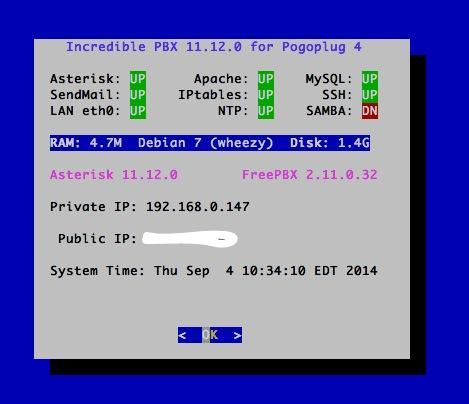
The Next 10 Steps. Before you do anything else, complete the following steps. It only takes a minute to secure and properly configure your server:
- Change your root password: passwd
- Change your FreePBX admin password: /root/admin-pw-change
- Set your correct time zone: /root/timezone-setup
- Expand partition to match SD card size: /root/resize-partition
- Add any desired IP addresses to WhiteList: /root/add-ip
- Decipher the randomized password for extension 701. It’s in the data field:
mysql -uroot -ppassw0rd -e "select * from asterisk.sip where id=701 and keyword='secret'"
- Decipher the randomized voicemail password for extension 701. It’s the first entry:
cat /etc/asterisk/voicemail.conf | grep 701 | cut -f 3 -d " "
- Enable Windows Networking, if desired: /root/samba-enable.sh
- Configure PPTP Network, if desired: cat /root/pptp-faq
- Check status to be sure everything is working: status
A Few Important Tips. Every operating system and service provider has their quirks. Ask Bill Gates! Debian and especially Comcast are no different. Fortunately, with Debian, it’s a very short list.
1. Use the following commands (only!) to shutdown and restart your server: halt and reboot. These commands are reworked in Incredible PBX to gracefully shutdown important services so that files don’t get damaged. Please use them!
2. If you ever want to move your server to a different network, complete these steps before you leave your existing network. First, using add-ip or add-fqdn, add the new WhiteList addresses for your new location using Option 0 (all privileges). Otherwise, you won’t be able to access your server once you move. Then issue the commands below. This will trigger a new Phase I update (outlined above) on the default network (eth0) using DHCP the next time you boot your Pogoplug.
touch /etc/update_hostconfig halt
3. You really do need email connectivity to get the most out of Incredible PBX. It’s the way you receive important notifications from FreePBX, and it’s also how voicemail messages are delivered. From the Linux CLI, test your server to be sure you can send emails reliably:
echo "test" | mail -s testmessage yourname@gmail.com
After checking your spam folder, if you really didn’t get the email, it may be that your service provider is blocking downstream SMTP traffic. You can use your provider’s SMTP server as a smarthost to send out mail with Exim4. Just run the following program to reconfigure the Exim mail server: dpkg-reconfigure exim4-config. Choose the SmartHost option and enter your provider’s SMTP address, e.g. smtp.comcast.net or smtp.knology.net. Exim will restart.
4. If you’d like to activate ODBC support for Asterisk including our ODBC sample applications including Speed Dial, here are the steps. Log into your server as root and issue the following commands:
cd /root wget http://incrediblepbx.com/odbc-pogoplug.tar.gz tar zxvf odbc-pogoplug.tar.gz rm odbc-pogoplug.tar.gz ./mysql-sample ./mysql-odbc ./odbc-gen.sh
Now you can try things out by dialing 222 from a phone connected to your server. When prompted for the employee number, enter 12345. Or dial 223 and, when prompted for the AsteriDex Dial Code, enter 263 (the first 3 letters of the American Airlines entry).
5. Want a list of your completed calls without using FreePBX? It’s easy:
mysql -uroot -ppassw0rd -e "SELECT SUBSTRING(calldate,6,11) AS calldate,clid,src,dst,duration from asteriskcdrdb.cdr WHERE disposition='ANSWERED' ORDER BY calldate DESC"
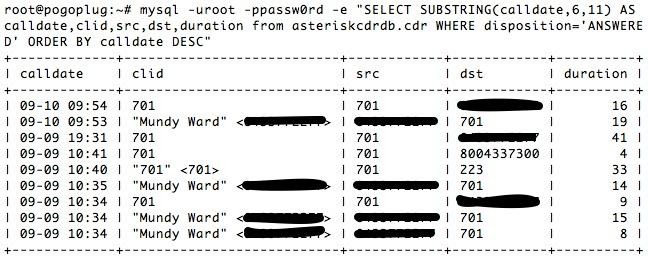
6. There may be situations in which it is desirable to use wireless networking instead of a wired connection with your Pogoplug. For under $10, you now can add WiFi. Here’s our post on the PIAF Forum to show you how.

Managing FreePBX with Incredible Backup and Restore
Unlike other releases of Incredible PBX, the backup and restore tools can be helpful on the Pogoplug platform. Even though Asterisk runs smoothly, calls sound great, and performance is pretty amazing, the FreePBX GUI is usable but a bit sluggish on the Pogoplug platform. If the performance bothers you, there’s a workaround. Create an Incredible Backup image of your Pogoplug, restore that image on a more normal Ubuntu 14 platform with ample RAM, and then make your FreePBX changes there using the FreePBX GUI. When you’re finished, make a backup of the changes, and then restore that backup to your Pogoplug. It sounds more complicated than it actually is. In essence, you’ll be transforming FreePBX into an Asterisk code generator. In fact, once a backup is restored, you can shut down your web server, and almost everything will still work. We were able to perform the entire procedure including updating all of the FreePBX modules and adding a Google Voice trunk in about 15 minutes using a snapshot of an Incredible PBX for Ubuntu 14 droplet we previously had created. Here are the actual steps to perform the first time:
1. Take an image snapshot of your server with Incredible Backup: /root/incrediblebackup
HINT: No need to do it initially. One is included: /backup/DU-2014.09.07.19.46-A11.12.0-F2.11-I11.12.0.tar.gz
2. Create a 512MB Droplet on Digital Ocean using Ubuntu 14 and Incredible PBX for Ubuntu. Follow the Nerd Vittles tutorial which also has a signup link to assist our projects. Coupon code: ALLSSD10 gets you a $10 credit this month. Once you’re up and running, you may want to take a snapshot so that you can quickly recreate droplets while also avoiding hourly charges for the one you’ve previously built (whether running or not!). Digital Ocean 512MB droplets cost less than a penny an hour so this is not a big ticket item. When you finish with the droplet, just destroy it (once you’ve made a snapshot!). Then the money meter stops. First time build takes about 30 minutes.
3. After creating /backup folder on DO droplet, copy your backup image from step #1 to this folder.
4. Restore the image: /root/incrediblerestore /backup/DU-somefilename.tar.gz
5. Open FreePBX on DO with a browser and log in as admin with your admin password.
6. Make all the changes desired using the tutorial below. Reload FreePBX (red bar) when prompted before exiting!
7. Make a DO backup of your new setup: /root/incrediblebackup
8. Copy the DO backup file to /backup on your Pogoplug.
9. Restore the DO backup: /root/incrediblerestore /backup/DU-somefilename.tar.gz
10. Log out and back into your Pogoplug as root.
Getting Started with VoIP and FreePBX
To access FreePBX, just point to the IP address of the server. The main control panel looks like this:
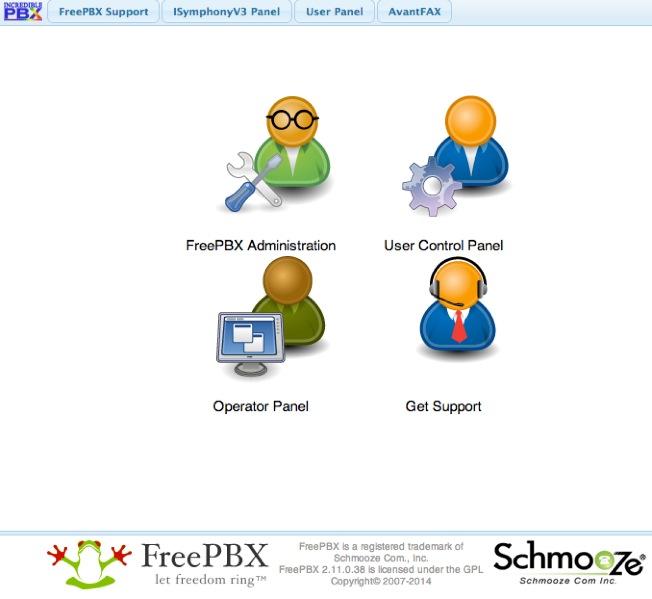
As configured, the default user account for FreePBX administration is admin. The password is whatever you set in the initial setup above. If you ever forget it, you can reset it easily: /root/admin-pw-change.
For those new to Asterisk and FreePBX, here’s a brief primer on what needs to happen before you can make and receive calls. If you have an existing Google Voice account, lucky you. This gets you a phone number for your PBX so people can call you. And it provides a vehicle to place free calls to plain old telephones in the U.S. and Canada so long as Google continues to provide the free service.
If you don’t have a Google Voice account or a shiny new smartphone, then you will need to purchase a SIP trunk from one of the numerous vendors around the world. Our favorite (because they provide terrific service at a modest price AND provide financial support to the Nerd Vittles, PBX in a Flash, and Incredible PBX projects) is Vitelity. Their special rates and a link for a discount are included at the end of today’s article.
Unlike POTS phone service from Ma Bell, the SIP World is a little different. First, you don’t need to put all your eggs in one basket. A trunk that gets you a phone number for incoming calls need not be with the same vendor that provides a trunk to place outbound calls. In fact, you may want multiple trunks for outbound calls just to have some redundancy. A list of our favorites in the U.S. and Canada is available on the PIAF Forum. Of course, there also are providers that offer all-you-can-eat calling plans. Two of our favorites are Vestalink and Future-Nine.
You’ll also need a softphone or SIP phone to actually place and receive calls. YATE makes a free softphone for PCs, Macs, and Linux machines so download your favorite and install it on your desktop.
Phones connect to extensions in FreePBX to work with Incredible PBX. Extensions talk to trunks (like Google Voice) to make and receive calls. FreePBX uses outbound routes to direct outgoing calls from extensions to trunks, and FreePBX uses inbound routes to route incoming calls from trunks to extensions to make your phones ring. In a nutshell, that’s how a PBX works.
There are lots of bells and whistles that you can explore down the road including voicemail, conferencing, IVRs, autoattendants, paging, intercoms, CallerID lookups, announcements, DISA, call parking and pickup, queues, ring groups, and on and on. And then there’s all of the Incredible PBX applications which are covered separately in this Nerd Vittles article. Once you’re comfortable with one server, you or your company will want some more. This Nerd Vittles article will walk you through interconnecting them into a seamless mesh network so that you can call from one office to another transparently. Yes, those articles were written for the Raspberry Pi. But the beauty of Incredible PBX is that it runs (almost) identically on every server platform.
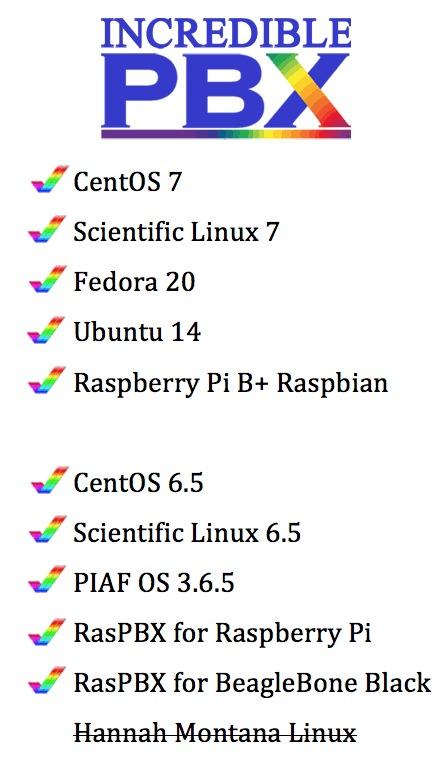
Here’s our 7-Step Checklist to Getting Started with FreePBX:
1. Setting Up Google Voice. If you want free calling in the U.S. and Canada, then you’ll need an existing Google Voice account that includes the Google Chat feature. You’ll need one dedicated to Incredible PBX, or it won’t work. Log out after setting up the new Google Voice account! Also note that Google Voice may cease to function at any time after May 15, 2014. You can read all about it here.
- Log into existing Google Voice account
- Enable Google Chat as Phone Destination
- Configure Google Voice Calls Settings:
- Call Screening – OFF
- Call Presentation – OFF
- Caller ID (In) – Display Caller’s Number
- Caller ID (Out) – Don’t Change Anything
- Do Not Disturb – OFF
- Call Options (Enable Recording) – OFF
- Global Spam Filtering – ON
- Place test call in and out using GMail Call Phone
- Log out of your Google Voice account
If this fails, then Google may have blocked your IP address. Here’s how to unblock it.
2. Activating a Google Voice Trunk. To create a Trunk in FreePBX to handle calls to and from Google Voice, you’ll need three pieces of information from the Google Voice account you set up above: the 10-digit Google Voice phone number, your Google Voice account name, and your Google Voice password. Choose Connectivity -> Google Voice (Motif) from the FreePBX GUI. The following form will appear:
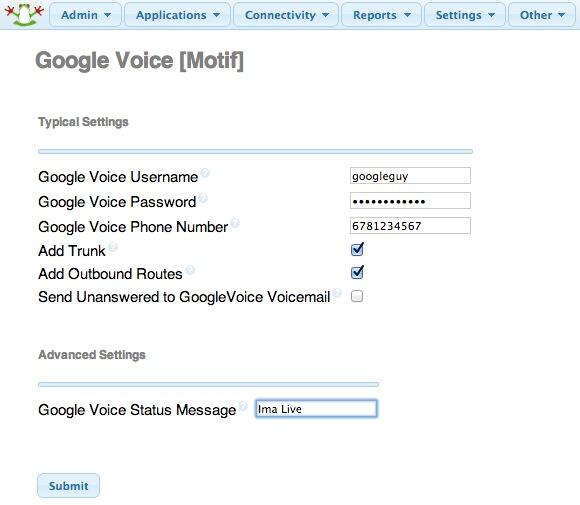
Fill in the blanks with your information and check only the top 2 boxes. If your Google Voice account name ends in @gmail.com, leave that out. Otherwise, include the full email address. Then click Submit Changes and Apply Config.
To activate a Google Voice trunk, you must restart Asterisk on the Pogoplug platform: amportal restart.
3. Setting a Destination for Incoming Calls. Now that you’ve created your Google Voice Trunk, we need to tell FreePBX how to process inbound calls when someone dials your Google Voice number. There are any number of choices. You could simply ring an extension. Or you could ring multiple extensions by first creating a Ring Group which is just a list of extension numbers. Or you could direct incoming calls to an Interactive Voice Response (IVR) system. By default, Incredible PBX is configured to route all incoming calls to extension 701. You can change the setting whenever you like by choosing Connectivity -> Inbound Routes -> Default. In the Set Destination section of the form, change the target destination from the pull-down lists.
Always click Submit and then click Apply Config to save new settings in FreePBX. This is especially important on the Pogoplug platform because you cannot actually do it once you restore the backup image to the Pogoplug.
4. Activating Additional Trunks with FreePBX. As we mentioned, there are lots of SIP providers to choose from. Once you have signed up for service, configuring the trunk is easy. Here is a quick Cheat Sheet courtesy of Kristian Hare, who translated our original setups into a spreadsheet. Just click on the image below to open it in a new window. Then click on the redisplayed image to enlarge it. The left and right cursor keys will move you around in the image. Click on the image again to shrink it.

5. Changing Extension Passwords. From the main FreePBX GUI, choose Applications -> Extensions. Then click on 701 in the Extension List on the right side of your display. You’ll see a form that looks like this:

For now, we only need to make a few changes. First, you need a very secure password for both the extension itself and your voicemail account for this extension. The extension secret needs to be a combination of letters and numbers. The Voicemail Password needs to be all numbers, preferably six or more. Replace the existing password entries with your own (very secure) entries. You also need to lock down this extension so that it is only accessible from devices on your private LAN. You do that with the deny and permit entries which currently are filled with zeroes. Leave the deny entry the way it is which tells Incredible PBX to block everybody except those allowed in the permit entry below. For the permit, we need the first three octets of your private LAN address, e.g. if your LAN is 192.168.0.something then the permit entry will be 192.168.0.0/255.255.255.0.
Finally, you need to plug in your actual email address in the Voicemail section so that voicemails can be delivered to you when someone leaves a message. You can also include a pager email address if you want a text message alert with incoming voicemails. If you want the voicemails to automatically be deleted from the server after they are emailed to you (a good idea considering the disk storage limitations of your microSD card), change the Delete Voicemail option from No to Yes. That’s it. Now save your settings by clicking the Submit button. Then reload the dialplan by clicking on the red prompt when it appears.
In case you’re curious, unless you’ve chosen to automatically delete voicemails after emailing them, you can retrieve your voicemails by dialing *98701 from any extension on your phone system. You’ll be prompted to enter the voicemail password you set up. In addition to managing your voicemails, you’ll also be given the opportunity to either return the call to the number of the person that called or to transfer the voicemail to another extension’s voicemail box. And you can always leave a voicemail for someone by dialing their extension number preceded by an asterisk, e.g. *701 would let someone leave you a voicemail without actually calling you.
6. Eliminating Audio and DTMF Problems. You can avoid one-way audio on calls and touchtones that don’t work with these simple settings in FreePBX: Settings -> Asterisk SIP Settings. Just plug in your public IP address and your private IP subnet. Then set ULAW as the only Audio Codec.
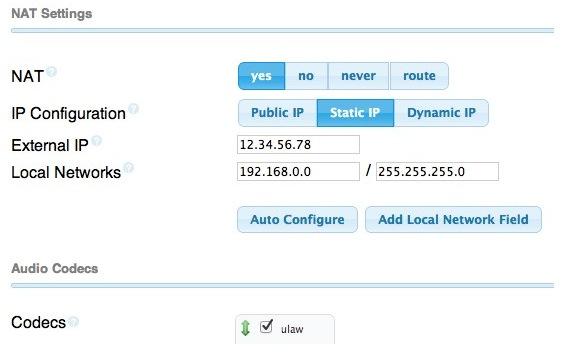
7. Configuring CallerID Superfecta. In order to match names with phone numbers, Incredible PBX includes a FreePBX application named CallerID Superfecta. Out of the box, Incredible PBX will work fine if you remember to activate CallerID Superfecta whenever you create a new Inbound Route. The CNAM entries also will be displayed in your CDR reports. For those not in the United States, you may prefer to use a lookup source for your numbers other than the ones preconfigured in CallerID Superfecta. You will find all of the available modules on the POSSA GitHub site. Just download the ones desired into /var/www/html/admin/superfecta/sources and then activate the desired sources in Admin -> CID Superfecta -> Default. You can test your results and the performance using the Debug facility that’s built into the module.
If you’re using FreePBX on an Ubuntu server in the Cloud, now is the time to drop down to the Linux command prompt, log in as root, and make a backup: /root/incrediblebackup. Copy the backup from /backup to the same folder on your Pogoplug and restore it: /root/incrediblerestore /backup/DU-somefilename.tar.gz. Then restart Asterisk on your Pogoplug: amportal restart. Finally, log out and back into your Pogoplug to assure that FreePBX will function properly on that platform.
Adding Speech Recognition for Incredible PBX Applications
We used to include Google’s Speech-to-Text service in earlier Incredible PBX builds. Unfortunately, Google has changed the rules a bit. Assuming your server still meets the "personal and development" standard, you can obtain an API key from Google and reactivate speech-to-text functionality for many of the Incredible PBX applications including Weather Reports by City (949), AsteriDex Voice Dialing by Name (411), SMS Dictator (767), and Wolfram Alpha for Asterisk (4747). To activate the STT service, just complete the steps in our tutorial. Then sign up for a Wolfram Alpha App ID (tutorial here), and run the following install scripts:
/root/wolfram/wolframalpha-oneclick.sh cp /root/pygooglevoice/bin/gvoice /usr/bin ln -s /usr/bin/gvoice /usr/local/sbin/gvoice cd /root/pygooglevoice python setup.py install /root/smsdictator/sms-dictator.sh
Configuring a YATE Softphone for Pogoplug
As we mentioned, the easiest way to get started with Incredible PBX is to set up a free YATE softphone on your Desktop computer. Versions are available at no cost for Macs, PCs, and Linux machines. Just download the appropriate one and install it from this link. Once installed, it’s a simple matter to plug in your extension 701 credentials and start making calls. Run the application and choose Settings -> Accounts and click the New button. Fill in the blanks using the IP address of Incredible PBX on the Pogoplug, 701 for your account name, and whatever password you’re using for the extension. Click OK.
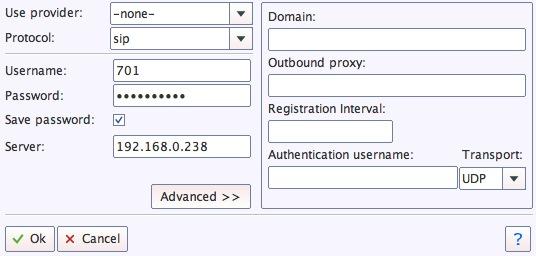
Once you are registered to extension 701, close the Account window. Then click on YATE’s Telephony Tab and place your first call. It’s that easy!
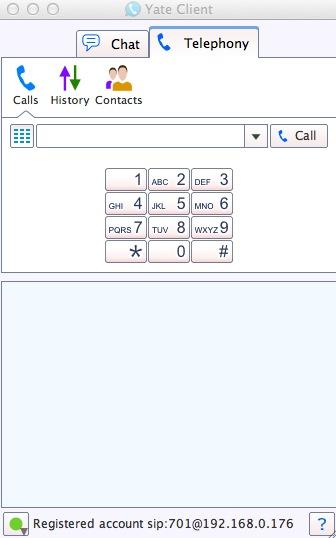
Introducing Incredible PBX 11.12.0 for the Pogoplug
For those of you that missed last week’s article on the CuBox platform and are new to Asterisk and the world of VoIP telephony, let us take a moment and explain how Incredible PBX fits into the puzzle. For lack of a better term, Incredible PBX is a turnkey aggregation in a bootable image that is based upon a superset of Debian 7 packages plus Asterisk, the FreePBX GUI, and a sizable collection of applications for the Asterisk platform. You download a tarball, decompress it, write the image file to an SD card, insert the card into your Pogoplug 4, and presto! You’ve got a turnkey PBX. Add credentials for a trunk or two to make and receive calls, connect some phones, and your SOHO office or home will come alive with a versatile PBX platform that used to cost organizations hundreds of thousands of dollars. What’s included in Incredible PBX? Glad you asked. Here’s a 3-minute video showcasing a few of our favorite Incredible PBX text-to-speech applications:
The Incredible PBX 11 Inventory. Here’s the current feature set on the Pogoplug platform. In addition to its superset of hundreds of Debian 7 packages, Asterisk 11, and FreePBX 2.11 with the Lighttpd web server, Exim 4 mail server, MySQL, PHP, phpMyAdmin, and the IPtables Linux firewall, check out these additions:
- AsteriDex: The Poor Man’s Rolodex®
- Asterisk Upgrade Utility (/root/upgrade-asterisk-cubox-bt)
- CallerID Superfecta (FreePBX Module adds Names to CID Numbers)
- CallWho for Asterisk (Dial by Voice from AsteriDex: 411)
- Preconfigured Email That Works with Exim 4
- OSS Endpoint Manager (Phone Configuration FreePBX module)
- Extensions (1 preconfigured with voicemail and randomized passwords)
- Google Speech Recognition for Incredible PBX apps (follow setup tutorial)
- Flite TTS for Asterisk (text-to-speech with Igor)
- GoogleTTS for Asterisk (Lefteris Zafiris’ state-of-the-art TTS)
- Google Voice (FreePBX GV/Motif Module for free U.S./Canada calls)
- Hotel-Style Wakeup Calls (FreePBX Module to simulate your favorite Holiday Inn)
- Incredible Backups… and Restores (see /root)
- Automated Incredible PBX Update Utility
- Lenny: The Telemarketer’s Worst Nightmare (dial L-E-N-N-Y)
- ODBC Database Support (Dial 222 with Employee Number 12345 to see what’s possible)
- Parking Lot Attendant (dial ## then 70 to simulate key telephones)
- Partition Resizing Utility for SD card expansion (/root/resize-partition)
- Phone Conference Bridge (Dial C-O-N-F for Private Conferences)
- PPTP Virtual Private Network (interconnect with other computers in minutes)
- Reminders by Phone and Web (supports recurring reminders and TTS delivery)
- SAMBA Windows Networking (Windows Networking Made Easy)
- SMS Dictator with Google Voice (Dial S-M-S to dictate and send an SMS message)
- Speech-to-Text Directory Assistance (Dial 411)
- Speed Dialer with AsteriDex (Dial 223 and enter first 3 letters of AsteriDex entry)
- Stealth AutoAttendant
- TimeZone Setup Utility (see /root)
- Today in History (Dial T-O-D-A-Y for today’s major events)
- Travelin’ Man 3 (IPtables WhiteList for rock-solid network security)
- Voice Dictation by Phone (Dial 5678)
- Weather by ZIP Code (Dial Z-I-P and enter any 5-digit zip code)
- Worldwide Weather by Phone (Dial 949 and say the name of your favorite city)
- Wolfram Alpha by Phone (/root/wolfram to install the world’s best almanac)
- Yahoo News by Phone (Dial 951 for the latest news headlines)
A Few Words About Security. Thanks to its Zero Internet Footprint™ design, Incredible PBX is different. It remains the most secure Asterisk-based PBX around. What this means is Incredible PBX has been engineered to sit anywhere, either behind a NAT-based, hardware firewall or directly on the Internet. No device other than those on your private LAN, a few of the major (trusted) SIP providers around the world, and those that you authorize on your WhiteList can even see your server. Additional IP addresses can be added to the WhiteList by the administrator registering new IP addresses using add-ip or add-fqdn from the Linux CLI. Read about this $100,000 VoIP phone bill, and you’ll better appreciate why WhiteList-based server security has become absolutely essential. WhiteList Security means only those devices with a registered IP address in your WhiteList can get to your server’s resources. To the NSA and everyone else, your server doesn’t even show up on the radar. Their only way to contact you is a POTS telephone using your published phone number. Our complete tutorial on Travelin’ Man 3 is available here. With Incredible PBX for the Pogoplug 4, it’s installed and preconfigured. Enjoy!
 Don’t forget to List Yourself in Directory Assistance so everyone can find you by dialing 411. And add your new number to the Do Not Call Registry to block telemarketing calls. Or just call 888-382-1222 from your new number.
Don’t forget to List Yourself in Directory Assistance so everyone can find you by dialing 411. And add your new number to the Do Not Call Registry to block telemarketing calls. Or just call 888-382-1222 from your new number.
Originally published: Monday, September 8, 2014
 Support Issues. With any application as sophisticated as this one, you’re bound to have questions. Blog comments are a terrible place to handle support issues although we welcome general comments about our articles and software. If you have particular support issues, we encourage you to get actively involved in the PBX in a Flash Forums. It’s the best Asterisk tech support site in the business, and it’s all free! Please have a look and post your support questions there. Our forum is extremely friendly and is supported by literally hundreds of Asterisk gurus. In fact, we already have a thread underway on the Pogoplug adventure.
Support Issues. With any application as sophisticated as this one, you’re bound to have questions. Blog comments are a terrible place to handle support issues although we welcome general comments about our articles and software. If you have particular support issues, we encourage you to get actively involved in the PBX in a Flash Forums. It’s the best Asterisk tech support site in the business, and it’s all free! Please have a look and post your support questions there. Our forum is extremely friendly and is supported by literally hundreds of Asterisk gurus. In fact, we already have a thread underway on the Pogoplug adventure.

Need help with Asterisk? Visit the PBX in a Flash Forum.
Special Thanks to Our Generous Sponsors
FULL DISCLOSURE: ClearlyIP, Skyetel, Vitelity, DigitalOcean, Vultr, VoIP.ms, 3CX, Sangoma, TelecomsXchange and VitalPBX have provided financial support to Nerd Vittles and our open source projects through advertising, referral revenue, and/or merchandise. As an Amazon Associate and Best Buy Affiliate, we also earn from qualifying purchases. We’ve chosen these providers not the other way around. Our decisions are based upon their corporate reputation and the quality of their offerings and pricing. Our recommendations regarding technology are reached without regard to financial compensation except in situations in which comparable products at comparable pricing are available from multiple sources. In this limited case, we support our sponsors because our sponsors support us.
 BOGO Bonaza: Enjoy state-of-the-art VoIP service with a $10 credit and half-price SIP service on up to $500 of Skyetel trunking with free number porting when you fund your Skyetel account. No limits on number of simultaneous calls. Quadruple data center redundancy. $25 monthly minimum spend required. Tutorial and sign up details are here.
BOGO Bonaza: Enjoy state-of-the-art VoIP service with a $10 credit and half-price SIP service on up to $500 of Skyetel trunking with free number porting when you fund your Skyetel account. No limits on number of simultaneous calls. Quadruple data center redundancy. $25 monthly minimum spend required. Tutorial and sign up details are here.
 The lynchpin of Incredible PBX 2020 and beyond is ClearlyIP components which bring management of FreePBX modules and SIP phone integration to a level never before available with any other Asterisk distribution. And now you can configure and reconfigure your new Incredible PBX phones from the convenience of the Incredible PBX GUI.
The lynchpin of Incredible PBX 2020 and beyond is ClearlyIP components which bring management of FreePBX modules and SIP phone integration to a level never before available with any other Asterisk distribution. And now you can configure and reconfigure your new Incredible PBX phones from the convenience of the Incredible PBX GUI.
 VitalPBX is perhaps the fastest-growing PBX offering based upon Asterisk with an installed presence in more than 100 countries worldwide. VitalPBX has generously provided a customized White Label version of Incredible PBX tailored for use with all Incredible PBX and VitalPBX custom applications. Follow this link for a free test drive!
VitalPBX is perhaps the fastest-growing PBX offering based upon Asterisk with an installed presence in more than 100 countries worldwide. VitalPBX has generously provided a customized White Label version of Incredible PBX tailored for use with all Incredible PBX and VitalPBX custom applications. Follow this link for a free test drive!
 Special Thanks to Vitelity. Vitelity is now Voyant Communications and has halted new registrations for the time being. Our special thanks to Vitelity for their unwavering financial support over many years and to the many Nerd Vittles readers who continue to enjoy the benefits of their service offerings. We will keep everyone posted on further developments.
Special Thanks to Vitelity. Vitelity is now Voyant Communications and has halted new registrations for the time being. Our special thanks to Vitelity for their unwavering financial support over many years and to the many Nerd Vittles readers who continue to enjoy the benefits of their service offerings. We will keep everyone posted on further developments.
Some Recent Nerd Vittles Articles of Interest…
- Some of our links refer users to Amazon or other service providers when we find their prices are competitive for the recommended products. Nerd Vittles receives a small referral fee from these providers to help cover the costs of our blog. We never recommend particular products solely to generate commissions. However, when pricing is comparable or availability is favorable, we support these providers because they support us. [↩]
Another Ride on the Wild Side: Introducing Incredible PBX for CentOS 6.5 and 7
If you’re not one to turn down a new challenge and you consider yourself an open source purist, then this Bud’s for you. Last month we introduced the latest and greatest Ubuntu 14 offering with Incredible PBX. And today it’s RedHat’s turn with the brand new CentOS 7. Be forewarned that CentOS 7 is a very different Linux animal than CentOS 6.5, and it’s just two weeks old. RHEL 7 is only six weeks old. There are more than a few potholes in RedHat’s latest pathway to heaven. This results in a number of direct consequences in any Asterisk® and FreePBX® communications server which depends upon CentOS 7 under the covers. For openers, anything proprietary probably won’t work for a while. That includes Digium phones and Schmooze Com’s commercial modules for FreePBX. In addition, FreePBX 2.11 and 12 were designed using PHP 5.3. CentOS 6.5 is distributed with PHP 5.4. Ubuntu 14 and Fedora 20 have PHP 5.5. There are some incompatibilities between all three versions, and many of us still are sorting out what impact those incompatibilities will have on the overall reliability of the FreePBX platform and some of the Incredible PBX applications. You can help by testing this new build in a non-production environment. 95% of the feature set available in the CentOS 6.5 platform still works fine. But finding the gotcha’s is going to take some time… and some pioneers. So… roll up your sleeves and lend us a hand!
Incredible PBX™ for CentOS 6.5 and 7 is an independent aggregation that does not rely upon PBX in a Flash™ for its roots. Because of the nature of the CentOS platform, it was built from the ground up. PBX in a Flash will follow once the stability of the CentOS 7 platform has been demonstrated. The Incredible PBX installer is pure GPL2 open source code so you are more than welcome (encouraged!) to examine it, improve upon it, and share your discoveries with all of us.
Incredible PBX for CentOS 6.5 and 7 follows our new install procedure which means it’s up to you to first create a CentOS 6.5 or 7 platform. If you prefer Scientific Linux or Oracle Linux, feel free to start there. All work equally well as a base platform. Then you run the Incredible PBX installer. After 30-60 minutes of whirring, you’ll end up with an awesome (free) state-of-the-art Asterisk-based VoIP server with the very latest version of Asterisk 11 and FreePBX 2.11 as well as dozens of turnkey Incredible PBX applications. So enjoy a nice lunch while the Incredible PBX installer works its magic. No user intervention is required during the installation procedure. All text-to-speech (TTS) applications work out of the box. You can add Google’s Speech Recognition to many Incredible PBX applications by following our 5-minute tutorial.
Installing a Base CentOS Operating System
Let’s begin by installing 64-bit CentOS 7 or 6.5 on your favorite hardware or Desktop. Or you may prefer to use a Cloud provider1 that already offers a preconfigured CentOS 7 image. In the latter case, you can skip this section.
For those using a dedicated hardware platform or wishing to install CentOS 7 as a virtual machine, the drill is the same. Start by downloading the CentOS 7 minimal ISO or the 64-bit CentOS 6.5 minimal ISO. We recommend the Everything ISO at the moment since there currently is no minimal install ISO. Burn the whopping ISO to a DVD unless you’ll be booting from the ISO on a virtual machine platform such as VirtualBox. On virtual platforms, we recommend at least 1GB RAM and a 20GB dedicated drive. For VirtualBox, here are the settings:
Type: Linux
Version: RedHat 64-bit
RAM: 1024MB
Default Drive Options with 20GB+ space
Create
Settings->System: Enable IO APIC and Disable HW Clock (leave rest alone)
Settings->Audio: Enable
Settings->Network: Enable, Bridged
Settings->Storage: Far right CD icon (choose your ISO)
Start
Boot your server with the ISO, and start the CentOS 7 install. Here are the simplest installation steps:
Choose Language and Click Continue
Click: Install Destination (do not change anything!)
Click: Done
Click: Network & Hostname
Click: ON
Click: Done
Click: Begin Installation
Click: Root Password: password, password, Click Done twice
Wait for Minimal Software Install and Setup to finish
Click: Reboot
Configuring CentOS 6.5 or 7 for Incredible PBX Installation
Now log into your server as root and issue the following commands to put the basic pieces in place and to reconfigure your Ethernet port as eth0. Make a note of your IP address so you can log in with SSH.
setenforce 0 yum -y upgrade yum -y install net-tools nano wget ifconfig # figure out your server IP address here sed -i 's|quiet|quiet net.ifnames=0 biosdevdame=0|' /etc/default/grub grub2-mkconfig -o /boot/grub2/grub.cfg # for CentOS/Scientific Linux 6.5/6.6 only, perform these additional steps: wget http://incrediblepbx.com/update-kernel-devel chmod +x update-kernel-devel ./update-kernel-devel reboot
If you’re on a virtual machine platform, now would be a good time to make an export or backup of your CentOS 7 image. The minimal install is about 500MB instead of 6.6GB. Don’t forget to first remove your hardware address (HWADDR) and network UUID from /etc/sysconfig/network-scripts/ifcfg-enp0s3 or whatever file name was assigned to your hardware. The saved image will be bootable with DHCP network support anywhere down the road.
NEWS FLASH: For those wanting to test things out using VirtualBox, a Scientific Linux 7 Minimal Install image (401MB) is now available on SourceForge. It gets you to right here in the install process.
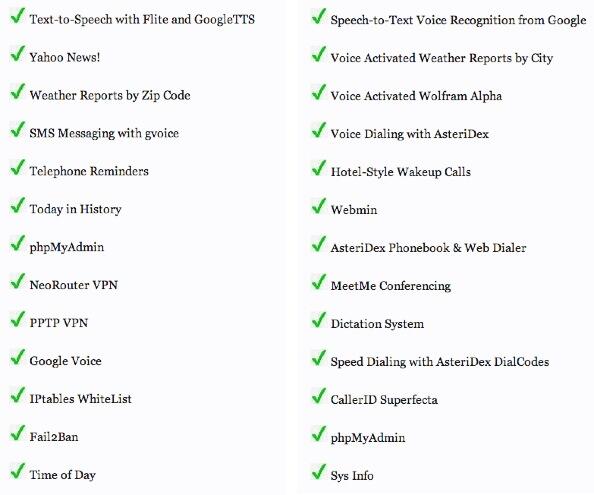
Installing Incredible PBX for CentOS 6.5 or 7
Adding Incredible PBX to a running CentOS 6.5 or 7 server is a walk in the park. To restate the obvious, your server needs a reliable Internet connection to proceed. Using SSH (or Putty on a Windows machine), log into your new server as root at the IP address you deciphered in the ifconfig step at the end of the CentOS installation procedure above.
WARNING: If you’re using a 512MB droplet at Digital Ocean, be advised that their Ubuntu setup does NOT include a swap file. This may cause serious problems when you run out of RAM. Uncomment ./create-swapfile-DO line below to create a 1GB swap file which will be activated whenever you exceed 90% RAM usage on Digital Ocean.
Now let’s begin the Incredible PBX install. Log back in as root and issue the following commands:
cd /root wget http://incrediblepbx.com/incrediblepbx11.4.centos.tar.gz tar zxvf incrediblepbx* #./create-swapfile-DO ./IncrediblePBX*
Once you have agreed to the license agreement and terms of use, press Enter and go have a long cup of coffee. The Incredible PBX installer runs unattended so find something to do for the next 30-60 minutes unless you just like watching code compile. When you see "Have a nice day", your installation is complete. Write down your admin password for FreePBX as well as your three “knock” ports for PortKnocker. If you forget them, you can reset your admin password by running /root/admin-pw-change. And you can retrieve your PortKnocker setup like this: cat /root/knock.FAQ.
Log out and back into your server as root and you should be greeted by something like this:
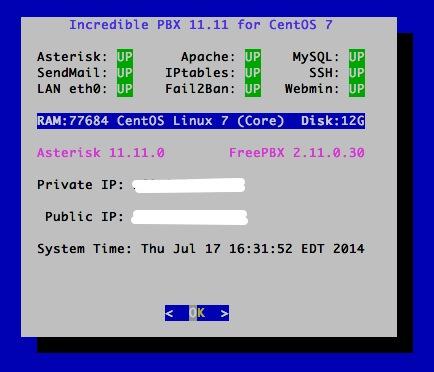
Or, if you started with a CentOS 6.5 or Scientific Linux 6.5 platform, you’ll see this:
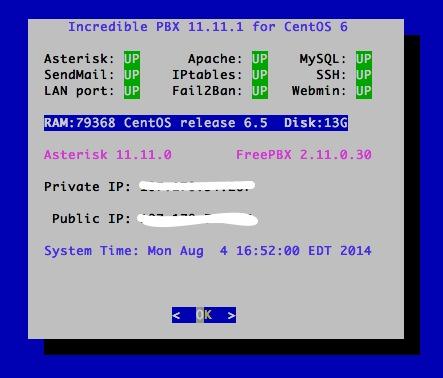
1. Access the Asterisk CLI by typing: asterisk -rvvvvvvvvvv
2. Set Your Correct Time Zone by typing: /root/timezone-setup
3. Change ALL of Your Passwords by typing: /root/update-passwords
You can access the FreePBX GUI using your favorite web browser to configure your server. Just enter the IP address shown in the status display. The default username is admin and the password is what you wrote down or reset when the install completed. Now edit extension 701 so you can figure out (or change) the randomized passwords that were set up for your 701 extension and voicemail account: Applications -> Extensions -> 701. If you’re behind a hardware-based firewall, change the NAT setting to: YES.
Setting Up a Soft Phone to Use with Incredible PBX
Now you’re ready to set up a telephone so that you can play with Incredible PBX. We recommend YateClient which is free. Download it from here. Run YateClient once you’ve installed it and enter the credentials for the 701 extension on Incredible PBX. You’ll need the IP address of your server plus your extension 701 password. Choose Settings -> Accounts and click the New button. Fill in the blanks using the IP address of your server, 701 for your account name, and whatever password you created for the extension. Click OK.

Once you are registered to extension 701, close the Account window. Then click on YATE’s Telephony Tab and place some test calls to the numerous apps that are preconfigured on Incredible PBX. Dial a few of these to get started:
947 - Weather by ZIP Code
951 - Yahoo News
*61 - Time of Day
*68 - Wakeup Call
TODAY - Today in History
Now you’re ready to connect to the telephones in the rest of the world. If you live in the U.S., the easiest way (at least for now) is to set up a free Google Voice account. Google has threatened to shut this down but as this is written, it still works. The more desirable long-term solution is to choose several SIP providers and set up redundant trunks for your incoming and outbound calls. The PIAF Forum includes dozens of recommendations to get you started.
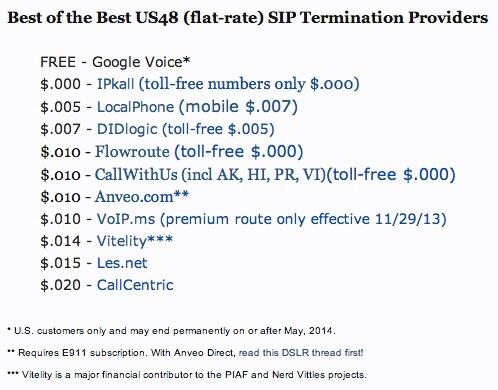
Configuring Google Voice
If you want to use Google Voice, you’ll need a dedicated Google Voice account to support Incredible PBX. If you want to use the inbound fax capabilities of Incredible Fax 11, then you’ll need an additional Google Voice line that can be routed to the FAX custom destination using FreePBX. The more obscure the username (with some embedded numbers), the better off you will be. This will keep folks from bombarding you with unsolicited Gtalk chat messages, and who knows what nefarious scheme will be discovered using Google messaging six months from now. So keep this account a secret!
We’ve tested this extensively using an existing Gmail account, and inbound calling is just not reliable. The reason seems to be that Google always chooses Gmail chat as the inbound call destination if there are multiple registrations from the same IP address. So, be reasonable. Do it our way! Set up a dedicated Gmail and Google Voice account, and use it exclusively with Incredible PBX 11. It’s free at least through 2013. Google Voice no longer is by invitation only so, if you’re in the U.S. or have a friend that is, head over to the Google Voice site and register.
You must choose a telephone number (aka DID) for your new account, or Google Voice calling will not work… in either direction. Google used to permit outbound Gtalk calls using a fake CallerID, but that obviously led to abuse so it’s over! You also have to tie your Google Voice account to at least one working phone number as part of the initial setup process. Your cellphone number will work just fine. Don’t skip this step either. Just enter the provided 2-digit confirmation code when you tell Google to place the test call to the phone number you entered. Once the number is registered, you can disable it if you’d like in Settings, Voice Setting, Phones. But…
IMPORTANT: Be sure to enable the Google Chat option as one of your phone destinations in Settings, Voice Setting, Phones. That’s the destination we need for The Incredible PBX to work its magic! Otherwise, all inbound and outbound calls will fail. If you don’t see this option, you may need to call up Gmail and enable Google Chat there first. Then go back to the Google Voice Settings.
While you’re still in Google Voice Settings, click on the Calls tab. Make sure your settings match these:
- Call Screening – OFF
- Call Presentation – OFF
- Caller ID (In) – Display Caller’s Number
- Caller ID (Out) – Don’t Change Anything
- Do Not Disturb – OFF
- Call Options (Enable Recording) – OFF
- Global Spam Filtering – ON
Click Save Changes once you adjust your settings. Under the Voicemail tab, plug in your email address so you get notified of new voicemails. Down the road, receipt of a Google Voice voicemail will be a big hint that something has come unglued on your PBX.
One final word of caution is in order regardless of your choice of providers: Do NOT use special characters in any provider passwords, or nothing will work!
Now you’re ready to set up your Google Voice trunk in FreePBX. After logging into FreePBX with your browser, click the Connectivity tab and choose Google Voice/Motif. To Add a new Google Voice account, just fill out the form. Do NOT check the third box or incoming calls will never ring!
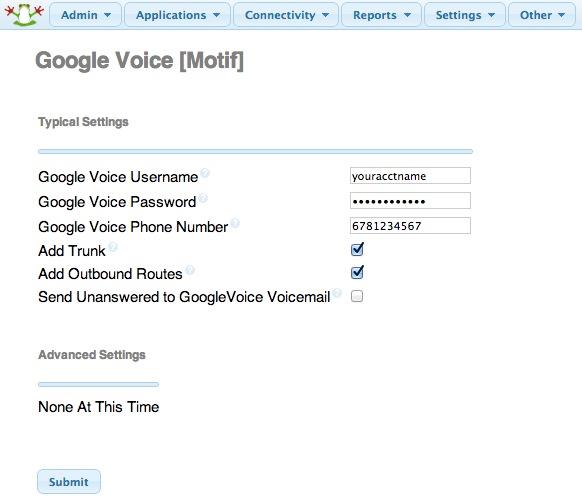
IMPORTANT LAST STEP: Google Voice will not work unless you restart Asterisk from the Linux command line at this juncture. Using SSH, log into your server as root and issue the following command: amportal restart.
If you have trouble getting Google Voice to work (especially if you have previously used your Google Voice account from a different IP address), try this Google Voice Reset Procedure. It usually fixes connectivity problems. If it still doesn’t work, enable Less Secure Apps using this Google tool.
Troubleshooting Audio and DTMF Problems
You can avoid one-way audio on calls and touchtones that don’t work with these simple settings in FreePBX: Settings -> Asterisk SIP Settings. Just plug in your public IP address and your private IP subnet. Then set ULAW as the only Audio Codec.

A Few Words about the Incredible PBX Security Model for CentOS 7
Incredible PBX for CentOS 7 joins last month’s Ubuntu 14 build as our most secure turnkey PBX implementation, ever. As configured, it is protected by both Fail2Ban and a hardened configuration of the IPtables Linux firewall. The latest release also includes Port Knocker for simple, secure access from any remote computer or smartphone. You can get up to speed on how the technology works by reading the Nerd Vittles tutorial. Your Port Knocker credentials are stored in /root/knock.FAQ together with activation instructions for your server and mobile devices. The NeoRouter VPN client also is included for rock-solid, secure connectivity to remote users. Read our previous tutorial for setup instructions. As configured, nobody can access your PBX without  your credentials AND
your credentials AND  an IP address that is either on your private network or that matches the IP address of your server or the PC from which you installed Incredible PBX. You can whitelist additional IP addresses by running the command-line utility /root/add-ip. You can remove whitelisted IP addresses by running /root/del-acct. Incredible PBX is preconfigured to let you connect to many of the leading SIP hosting providers without additional firewall tweaking. We always recommend you also add an extra layer of protection by running your server behind a hardware-based firewall with no Internet port exposure, but that’s your call. And it’s your phone bill. 😉
an IP address that is either on your private network or that matches the IP address of your server or the PC from which you installed Incredible PBX. You can whitelist additional IP addresses by running the command-line utility /root/add-ip. You can remove whitelisted IP addresses by running /root/del-acct. Incredible PBX is preconfigured to let you connect to many of the leading SIP hosting providers without additional firewall tweaking. We always recommend you also add an extra layer of protection by running your server behind a hardware-based firewall with no Internet port exposure, but that’s your call. And it’s your phone bill. 😉
The IPtables firewall is a complex piece of software. If you need assistance with configuring it, visit the PIAF Forum for some friendly assistance.
Incredible Backup and Restore
We’re pleased to introduce our latest backup and restore utilities for Incredible PBX. Running /root/incrediblebackup will create a backup image of your server in /tmp. This backup image then can be copied to any other medium desired for storage. To restore it to another Incredible PBX 11 server, simply copy the image to a server running Asterisk 11 and FreePBX 2.11 and run /root/incrediblerestore. Doesn’t get much simpler than that.
Incredible PBX Automatic Update Utility
Every time you log into your server as root, Incredible PBX will ping the IncrediblePBX.com web site to determine whether one or more updates are available to bring your server up to current specs. We recommend you log in at least once a week just in case some new security vulnerability should come along.
In the meantime, we encourage you to sign up for an account on the PIAF Forum and join the discussion. In addition to providing first-class, free support, we think you’ll enjoy the camaraderie.
Incredible PBX: Pick Your Poison
We fully appreciate that Bleeding Edge technology isn’t right for everyone. Fortunately, with Incredible PBX, you have lots of options, and they’re all free. Come join the party and see what you’ve been missing.

Originally published: Monday, July 20, 2014
 Support Issues. With any application as sophisticated as this one, you’re bound to have questions. Blog comments are a terrible place to handle support issues although we welcome general comments about our articles and software. If you have particular support issues, we encourage you to get actively involved in the PBX in a Flash Forums. It’s the best Asterisk tech support site in the business, and it’s all free! Please have a look and post your support questions there. Unlike some forums, ours is extremely friendly and is supported by literally hundreds of Asterisk gurus and thousands of users just like you. You won’t have to wait long for an answer to your question.
Support Issues. With any application as sophisticated as this one, you’re bound to have questions. Blog comments are a terrible place to handle support issues although we welcome general comments about our articles and software. If you have particular support issues, we encourage you to get actively involved in the PBX in a Flash Forums. It’s the best Asterisk tech support site in the business, and it’s all free! Please have a look and post your support questions there. Unlike some forums, ours is extremely friendly and is supported by literally hundreds of Asterisk gurus and thousands of users just like you. You won’t have to wait long for an answer to your question.

Need help with Asterisk? Visit the PBX in a Flash Forum.
Special Thanks to Our Generous Sponsors
FULL DISCLOSURE: ClearlyIP, Skyetel, Vitelity, DigitalOcean, Vultr, VoIP.ms, 3CX, Sangoma, TelecomsXchange and VitalPBX have provided financial support to Nerd Vittles and our open source projects through advertising, referral revenue, and/or merchandise. As an Amazon Associate and Best Buy Affiliate, we also earn from qualifying purchases. We’ve chosen these providers not the other way around. Our decisions are based upon their corporate reputation and the quality of their offerings and pricing. Our recommendations regarding technology are reached without regard to financial compensation except in situations in which comparable products at comparable pricing are available from multiple sources. In this limited case, we support our sponsors because our sponsors support us.
 BOGO Bonaza: Enjoy state-of-the-art VoIP service with a $10 credit and half-price SIP service on up to $500 of Skyetel trunking with free number porting when you fund your Skyetel account. No limits on number of simultaneous calls. Quadruple data center redundancy. $25 monthly minimum spend required. Tutorial and sign up details are here.
BOGO Bonaza: Enjoy state-of-the-art VoIP service with a $10 credit and half-price SIP service on up to $500 of Skyetel trunking with free number porting when you fund your Skyetel account. No limits on number of simultaneous calls. Quadruple data center redundancy. $25 monthly minimum spend required. Tutorial and sign up details are here.
 The lynchpin of Incredible PBX 2020 and beyond is ClearlyIP components which bring management of FreePBX modules and SIP phone integration to a level never before available with any other Asterisk distribution. And now you can configure and reconfigure your new Incredible PBX phones from the convenience of the Incredible PBX GUI.
The lynchpin of Incredible PBX 2020 and beyond is ClearlyIP components which bring management of FreePBX modules and SIP phone integration to a level never before available with any other Asterisk distribution. And now you can configure and reconfigure your new Incredible PBX phones from the convenience of the Incredible PBX GUI.
 VitalPBX is perhaps the fastest-growing PBX offering based upon Asterisk with an installed presence in more than 100 countries worldwide. VitalPBX has generously provided a customized White Label version of Incredible PBX tailored for use with all Incredible PBX and VitalPBX custom applications. Follow this link for a free test drive!
VitalPBX is perhaps the fastest-growing PBX offering based upon Asterisk with an installed presence in more than 100 countries worldwide. VitalPBX has generously provided a customized White Label version of Incredible PBX tailored for use with all Incredible PBX and VitalPBX custom applications. Follow this link for a free test drive!
 Special Thanks to Vitelity. Vitelity is now Voyant Communications and has halted new registrations for the time being. Our special thanks to Vitelity for their unwavering financial support over many years and to the many Nerd Vittles readers who continue to enjoy the benefits of their service offerings. We will keep everyone posted on further developments.
Special Thanks to Vitelity. Vitelity is now Voyant Communications and has halted new registrations for the time being. Our special thanks to Vitelity for their unwavering financial support over many years and to the many Nerd Vittles readers who continue to enjoy the benefits of their service offerings. We will keep everyone posted on further developments.
Some Recent Nerd Vittles Articles of Interest…
- Some of our links refer users to Amazon or other service providers when we find their prices are competitive for the recommended products. Nerd Vittles receives a small referral fee from these providers to help cover the costs of our blog. We never recommend particular products solely to generate commissions. However, when pricing is comparable or availability is favorable, we support these providers because they support us. [↩]
The Definitive VoIP Quickstart Guide: Incredible PBX for the Raspberry Pi
 It’s been a wild ride with the $35 Raspberry Pi®. Last month, sales of the Raspberry Pi topped three million. And, if you didn’t already know, the Raspberry Pi makes a near perfect platform for your very own VoIP PBX. It’s less than a ONE HOUR project!
It’s been a wild ride with the $35 Raspberry Pi®. Last month, sales of the Raspberry Pi topped three million. And, if you didn’t already know, the Raspberry Pi makes a near perfect platform for your very own VoIP PBX. It’s less than a ONE HOUR project!
[iframe-popup id="3″]
If you’re new to the party, imagine squeezing a 700 mHz ARM processor with 512MB of RAM, 2 USB ports, a 10/100 Ethernet port, an HDMI port, composite video, a separate audio jack, an SDHC card slot, and a micro USB port onto a motherboard the size of a credit card weighing 1.6 ounces. Adding WiFi is as simple as plugging in a USB adapter. If your WiFi connection is password-protected, just plug your credentials into the top of /etc/wpa.conf and /root/restart-wlan0.
07/01/2019 NEWS FLASH: Just released Incredible PBX LITE for the Raspberry Pi 2, 3, and 4 featuring Raspbian 10 Buster. Tutorial here.
Absolute perfection. Other than the slow write speeds to the sd card (you might add a warning note about that part), I had it swapped over to local extension numbers and trunked to existing asterisk servers in minutes… [I]t doesn’t get any cooler than this! — Scott P.
Trust us when we say the performance of this tiny computer is nothing short of amazing. Can it do everything a $300 dual-core Atom PC can do? No. Can it do 90% of everything for someone whose requirements do not exceed a handful of simultaneous calls at a time but still wants a full-blown PBX for call routing, transcribed voicemails delivered by email, IVRs, music on hold, and text-to-speech and speech-to-text apps for a home, a SOHO office, a Little League team, or a dorm room? Absolutely. As Scott mentioned, configuration changes may take you a few seconds longer than would normally be the case with an Atom-based PC and a hard disk. But, hey, you can have this delivered to your front door in two days with Amazon Prime shipping for less than $2 more than the actual cost of the $35 computer. See the ad in the sidebar for ordering info. You’ll have a fully functional PBX up and running before you can break a summer sweat.
And today we’re pleased to introduce Incredible PBX 3.11.10 for the Raspberry Pi, a turnkey PBX featuring the latest releases of Asterisk® 11 and FreePBX® 2.11 for a near perfect telephony platform. Special thanks to the tens of thousands of pioneers that have given the first dozen iterations of this software a healthy workout over the past 18 months. We couldn’t have done it without you!
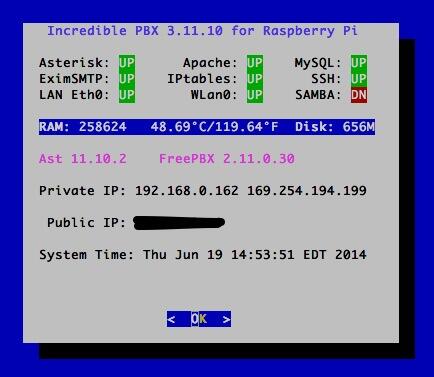
What’s New in Incredible PBX 3.11.10? Well, just about everything is either new or upgraded. For those of you already running a previous version, here’s a quick thumbnail of the 3.11.10 feature set. As in the past, we’ve tried to mimic as much of the previous build functionality as possible while providing new firmware support for the very latest Raspberry Pi boards. So you still get simple utilities to configure 1GHz overclocking and automatic expansion of the 3.11 image to run on any size SDHC card. You also get Asterisk’s latest long-term support release, Asterisk 11, which provides an incredibly stable VoIP platform. There also have been some major plumbing enhancements in FreePBX 2.11 to improve its stability and to enhance security. Although we can’t promise it will last forever, you also still get Google Voice support with free calling in the U.S. and Canada as well as free faxing and SMS messaging plus most of the Incredible PBX feature set. We’ve also added optional voice transcription and email delivery of MP3 voicemails to smooth the migration to unified messaging. If you want the first 15 seconds of each voicemail transcribed, then issue the following commands after logging into your server as root. Additional documentation is available here.
cd /usr/sbin
mv sendmailmp3 sendmailmp3.notrans
mv /root/sendmailmp3 sendmailmp3
Incredible PBX 3.5 and beyond added automatic detection and support of 512MB Raspberry Pi devices without touching anything. Beginning with version 3.7, we added an awesome fax server to Incredible PBX for those with a 512MB board. The complete tutorial is available here. update-my-pi in the /root folder of your server helps to safeguard your system by bringing it up to date with the latest fixes and enhancements. After running it the first time, it gets run automatically whenever you log in as root. For the safety of your server, don’t disable it! It’s free for the first ten updates, and then it’s just $20 a year. And it’s on the honor system so you can cheap out if you prefer not to contribute.
To enable overclocking at your own risk, run: raspi-config. Overclocking works for us. YMMV! The key is a good power supply. If you’re using an SD card larger than 4GB, version 3.11.10 can resize your partitions on the fly. Just choose the option in raspi-config and reboot. Even though the kernel now monitors CPU temperature and manages overclocking, it’s always nice to see for yourself. To monitor the CPU temperature, just run the status program which provides a current snapshot anytime. Temperature data now is provided on the FreePBX Dashboard as well.

There’s more good news. Networking is much more stable; however, we’ve dropped support for the TP-Link WiFi adapters. If you still have one of these adapters, see this thread on the PIAF Forum for setup instructions. Otherwise you’ll need the recommended AirLink 101 N-150 if you want WiFi capability. In the 3.11.10 release, your server will automatically attempt to connect to any open WiFi network that it can find. We’ve also added two scripts in /root to let you restart either your wired or wireless network and designate it as the primary network: restart-eth0 and restart-wlan0. Time zone management was also a bit of mess with multiple file settings required to support both Linux and PHP. In this release, you’ll be prompted to select your timezone when you first log in as root. The setup script will automatically apply your entry in all the right places. We’ve also replaced SendMail with Exim to simplify the process of using an SMTP mail gateway such as Gmail. The procedure for making the change is documented here.
As part of the latest build, we’ve also eliminated the pi user account. Everything you need to do to configure Incredible PBX requires root permission. So goodbye sudo. Only the root user account is included, and the default password is raspberry. Change the password when you first log in. New SSH and DUNDI keys now are automatically generated when you first boot your server. The FreePBX Backup and Restore Utility is included in this new build. AsteriDex Speed Dialing has been enhanced for our friends across the Atlantic. Enter 3-digit Dial Codes in AsteriDex, and you can call by dialing 000nnn. In this upgrade, Telephone Reminders work like a champ.
X Windows is included in this build. This won’t work with SSH. For a demo slideshow, plug in a real monitor and log in as root. In the /root folder, enter the command: startx. To end the slideshow, press ESCape. To disable the slideshow: mv .xinitrc xinitrc. To add photos, copy .jpg images into /root/slideshow. No mouse is required for the slideshow but, if you run X Windows natively, you’ll need a USB mouse. The SMS Blasting app in /root now supports phone numbers (which use SMS) and email addresses (which use SendMail).
Last but not least, a sophisticated Conference Bridge has been added to Incredible PBX. If you route one of your inbound DIDs to the predefined IVR, users can press 0 and enter 1234 for the conference PIN to join the conference. Local extensions simply dial C-O-N-F. We’ve already tested a 9-person conference call with excellent results. But don’t take our word for it. Try it for yourself. Just call our demo Raspberry Pi AutoAttendant and take the Conference Bridge and a handful of other Incredible PBX™ apps for a test drive:

And here’s what the conference call looked like in the FreePBX Dashboard:

So you don’t have to jump around between articles, we’ve put together this Quick Start Guide that tells you everything you need to know to get up and running in about an hour. Most of that time will be consumed copying the Incredible Pi image to an SD card. So there’s plenty of time for lunch during the hour. Once your system is running and you’ve completed the setup steps below, then jump over to the application tutorial which explains how to use every one of the 35+ Incredible PBX Apps for the $35 Raspberry Pi.
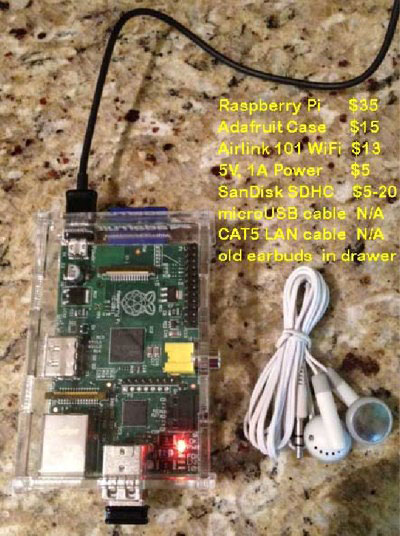
What to Buy. Here’s everything you need to get started.1 The case is optional. Yes, you can run the Raspberry Pi sitting on your desk with no case. It’s only 5 volts. WiFi is also optional. There’s a 10/100 port on the Raspberry Pi that gives you all the networking you need. Here are the links to buy the pieces. You also need a CAT5 cable and either a spare PC or Mac with Putty or SSH and a pair of earbuds or an HDMI cable to connect to a TV or monitor and a USB keyboard.
- $35 512MB Raspberry Pi from MCM or Newark or Amazon
- $10 Power Adapter (this one is rock solid!)
- $10 SanDisk 16GB SDHC Type 4 card
- $15 Adafruit Acrylic Case
- $13 AirLink 101 N150 WiFi Adapter or Adafruit Mini WiFi Adapter
Setting Up Google Voice. If you want free calling in the U.S. and Canada, then you’ll need a Google Voice account, and you’ll need one dedicated to Incredible Pi, or it won’t work. Log out after setting up the new Google Voice account! Also note that Google Voice will cease to function on May 15, 2014. You can read all about it here.
- Register for Google Voice account (no funky characters in your password!)
- Enable Google Chat as Phone Destination
- Configure Google Voice Calls Settings:
- Call Screening – OFF
- Call Presentation – OFF
- Caller ID (In) – Display Caller’s Number
- Caller ID (Out) – Don’t Change Anything
- Do Not Disturb – OFF
- Call Options (Enable Recording) – OFF
- Global Spam Filtering – ON
- Place test call in and out using GMail Call Phone
Baking Your Incredible Pi. The disk drive for the Raspberry Pi is an SD card. So what you need to do is download Incredible Pi and copy the image onto an SDHC card. Mac and Linux installers are included. For Windows, just use Win32 Disk Imager. Here are the steps:
- Download the latest Incredible Pi package
- Decompress the tarball: tar zxvf incrediblepi-version.tar.gz
- Copy .img file to SDHC using image utility or script
- Insert SDHC card into Raspberry Pi
- Boot the Raspberry Pi from Incredible Pi SDHC card
Your First Bite of Incredible Pi. If you’re not using a monitor and keyboard, you can use SSH to gain root access to Incredible Pi. And you can use any web browser on your private network to access your server. There are a couple of hurdles. First, you need the network address of your new server. And, second you need an SSH client. With Incredible PBX 3.3 and beyond, you needn’t worry about the IP address. You now can access your server via SSH by logging in like this: root@incrediblepbx.local. And browser access to your server is available at the following address: http://incrediblepbx.local. You still can plug in some earbuds when the bootup process begins and listen for the Incredible Pi to tell you its IP address when the boot procedure completes (about 90 seconds). Then you can use that IP address instead of incrediblepbx.local. The latest releases of Incredible PBX also include a Java-based SSH client in the FreePBX web GUI: Admin -> Java SSH. Because of the almost weekly security problems with Java, we strongly recommend using a standalone SSH client such as Putty.
Here’s everything you need to know about security for Incredible Pi:
1. ALWAYS RUN INCREDIBLE PI BEHIND A SECURE HARDWARE-BASED FIREWALL/ROUTER
2. NEVER EXPOSE ANY INCREDIBLE PI PORTS DIRECTLY TO THE INTERNET
3. NEVER MAP INBOUND INTERNET PORTS FROM YOUR FIREWALL TO INCREDIBLE PI
Initial Setup. There also are a few setup steps to complete once your Incredible Pi finishes the bootup process. When you first login (username: root password: raspberry), you’ll be prompted to change your root password and to set your default time zone. If you’re using either a wired network or an open WiFi network, then everything just works. If you’re using secured WiFi, then you’ll need to plug in your credentials in /etc/wpa.conf and reboot. The wired network always takes precedence so unplug the cable if you want WiFi to be your primary network. /root/update-my-pi runs automatically when you log in as root. It will bring your server up to current specs. Finally, now’s the time to repartition your SD card if you’re using a card larger than 4GB (highly recommended!). While you’re at it, bump up the performance of your Raspberry Pi by 50% by setting the overclocking to turbo mode. It works great for us. YMMV! The key is a rock-solid power adapter such as the one we’ve recommended. Just run raspi-config and follow your nose.
Accessing Incredible Pi By GUI. You don’t have to be a Linux guru to use Incredible Pi. In fact, we’re just about finished with the Linux command prompt, but stay logged in until we finish the steps below. Most of your configuration of the PBX will be performed using the FreePBX® Web GUI.
If you’re new to Asterisk® and FreePBX, here’s the one paragraph primer on what needs to happen before you can make free calls with Google Voice. You’ll obviously need a free Google Voice account. This gets you a phone number for people to call you and a vehicle to place calls to plain old telephones throughout the U.S. and Canada at no cost. You’ll also need a softphone or SIP phone to actually place and receive calls. YATE makes a free softphone for PCs, Macs, and Linux machines so download your favorite and install it on your desktop. Phones connect to extensions in FreePBX to work with Incredible Pi. Extensions talk to trunks (like Google Voice) to make and receive calls. FreePBX uses outbound routes to direct outgoing calls from extensions to trunks, and FreePBX uses inbound routes to route incoming calls from trunks to extensions to make your phones ring. In a nutshell, that’s how a PBX works. There are lots of bells and whistles that you can explore down the road.
Let’s get started. Using a browser, enter the IP address of your server or just use incrediblepbx.local as the address. Choose FreePBX Administration. When prompted for a username and password, use admin for both. Here are the six steps you need to complete before making your first free call:
- Change FreePBX admin Password and Default Email
- Add Google Voice Account credentials
- Set Destination for Incoming Calls
- Change Extension 701 Passwords
- Eliminate Audio and DTMF Problems
- Install and Register a Softphone to Extension 701
1. Changing FreePBX admin Password and Default Email. From the main FreePBX GUI, click Admin => Administrators. Click on admin user in the far-right column. Enter a new Password and click Submit Changes button. Then click the Apply Config button. Next, set your default email address in the right margin of Admin -> Module Admin and save your entry.
2. Activating a Google Voice Trunk. To create a Trunk in FreePBX to handle calls to and from Google Voice, you’ll need three pieces of information from the Google Voice account you set up above: the 10-digit Google Voice phone number, your Google Voice account name, and your Google Voice password. Choose Connectivity -> Google Voice (Motif) from the FreePBX GUI. The following form will appear:

Fill in the blanks with your information and check only the top 2 boxes. If your Google Voice account name ends in @gmail.com, leave that out. Otherwise, include the full email address. Then click Submit Changes and Apply Config.
There’s one more step or your Google Voice account won’t work reliably with Incredible Pi! From the Linux command prompt while logged into your server as root, restart Asterisk: amportal restart
3. Setting a Destination for Incoming Calls. Now that you’ve created your Google Voice Trunk, we need to tell FreePBX how to process inbound calls when someone dials your Google Voice number. There are any number of choices. You could simply ring an extension. Or you could ring multiple extensions by first creating a Ring Group which is just a list of extension numbers. Or you could direct incoming calls to an Interactive Voice Response (IVR) system (we’ve actually set one up for you to play with).
By default, Incredible Pi is configured to route all incoming calls to a demo IVR that shows off some of the applications that come with Incredible Pi. You can change whenever you like by choosing Connectivity -> Inbound Routes -> Default. In the Set Destination section of the form, change the target to Extensions and then select 701 from the list. Then click Submit and Apply Config.
4. Changing Extension Passwords. From the main FreePBX GUI, choose Applications -> Extensions. Then click on 701 in the Extension List on the right side of your display. You’ll see a form that looks like this:

For now, we only need to make a few changes. First, you need a very secure password for both the extension itself and your voicemail account for this extension. The extension secret needs to be a combination of letters and numbers. The Voicemail Password needs to be all numbers, preferably six or more. Replace the existing 1234secret and 1234 with your own (very secure) entries. You also need to lock down this extension so that it is only accessible from devices on your private LAN. You do that with the deny and permit entries which currently are filled with zeroes. Leave the deny entry the way it is which tells Incredible Pi to block everybody except those allowed in the permit entry below. For the permit, we need the first three octets of your private LAN address, e.g. if your LAN is 192.168.0.something then the permit entry will be 192.168.0.0/255.255.255.0.
Finally, you need to plug in your actual email address in the Voicemail section so that voicemails can be delivered to you when someone leaves a message. You can also include a pager email address if you want a text message alert with incoming voicemails. If you want the voicemails to automatically be deleted from the server after they are emailed to you (a good idea considering the disk storage limitations of an SDHC card), change the Delete Voicemail option from No to Yes. That’s it. Now save your settings by clicking the Submit button. Then reload the dialplan by clicking on the red prompt when it appears.
In case you’re curious, unless you’ve chosen to automatically delete voicemails after emailing them, you can retrieve your voicemails by dialing *98701 from any extension on your phone system. You’ll be prompted to enter the voicemail password you set up. In addition to managing your voicemails, you’ll also be given the opportunity to either return the call to the number of the person that called or to transfer the voicemail to another extension’s voicemail box. And you can always leave a voicemail for someone by dialing their extension number preceded by an asterisk, e.g. *701 would let someone leave you a voicemail without actually calling you.
5. Eliminating Audio and DTMF Problems. You can avoid one-way audio on calls and touchtones that don’t work with these simple settings in FreePBX: Settings -> Asterisk SIP Settings. Just plug in your public IP address and your private IP subnet. Then set ULAW as the only Audio Codec.

6. Setting Up a Desktop Softphone. Incredible Pi supports all kinds of telephones, but we’ll start with the easy (free) one today. You can move on to "real phones" once you’re smitten with the VoIP bug. For today, you’ll need to download a softphone to your desktop PC or Mac.
7. Activating Voice Recognition for Incredible Pi Apps. Google now requires an API key to use their voice recognition services. This affects a number of Incredible Pi applications including the Yahoo Weather report service (951) which lets you say the name of a city to retrieve its weather forecast, dial by name to call anyone in your AsteriDex database (411), and the Wolfram Alpha almanac service which lets you look up almost anything (4747). The 5-minute tutorial to activate voice recognition is available in the PIAF Forum.
As we mentioned, the easiest way to get started with Incredible Pi is to set up a YATE softphone on your Desktop computer. Versions are available at no cost for Macs, PCs, and Linux machines. Just download the appropriate one and install it from this link. Once installed, it’s a simple matter to plug in your extension 701 credentials and start making calls. Run the application and choose Settings -> Accounts and click the New button. Fill in the blanks using the IP address of Incredible Pi, 701 for your account name, and whatever password you created for the extension. Click OK.

Once you are registered to extension 701, close the Account window. Then click on YATE’s Telephony Tab and place your first call. It’s that easy!

Monitoring Call Progress with Asterisk. That about covers the basics. We’ll leave you with a tip on how to monitor what’s happening with your PBX. There are several good tools within the FreePBX GUI. You’ll find them under the Reports tab. In addition, Asterisk has its own Command Line Interface (CLI) that is accessible from the Linux command prompt. Just execute the following command while logged in as root: asterisk -rvvvvvvvvvv.
Activating SAMBA for Windows Networking. SAMBA is included for transparent access using the Windows Networking Protocol from PCs, Macs, and other Linux machines. As delivered, SAMBA is deactivated. For obvious reasons, we recommend you never activate root login access to SAMBA without a very secure password. If you wish to enable SAMBA on your server, here are the steps while logged in as root:
- 1. Set SAMBA password for user root: smbpasswd -a root
- 2. Change Windows workgroup from WORKGROUP, if needed: nano -w /etc/samba/smb.conf
- 3. Manually start SAMBA from command prompt: service samba start
- 4. If desired, set SAMBA to start on boot: rcconf and activate SAMBA option
Activating the PPTP VPN Client. If you’ve followed the Nerd Vittles tutorial and previously set up a PPTP VPN Server for your devices, then it’s pretty simple to add Incredible Pi to the mix by activating its PPTP VPN client. You’ll need the FQDN or public IP address of your VPN server as well as a username and password for VPN access to your VPN server. Once you have those in hand, log into Incredible Pi as root.
Lest we forget to mention, you cannot log into your PPTP server from an IP address on the same private LAN so you’d only use the PPTP VPN when your Incredible Pi is at a remote location.
Edit the connection template: nano -w /etc/ppp/peers/my-pptp-server. Insert the following text and replace myfqdn.org with the FQDN of your PPTP server, replace myname with your PPTP username, and replace mypassword with your PPTP password. Then save the file: Ctrl-X, Y, then Enter.
To test it, issue the following command: /etc/init.d/pptp start. When you run ifconfig, you should now see a ppp0 entry:
ppp0 Link encap:Point-to-Point Protocol
UP POINTOPOINT RUNNING NOARP MULTICAST MTU:1500 Metric:1
RX packets:0 errors:0 dropped:0 overruns:0 frame:0
TX packets:0 errors:0 dropped:0 overruns:0 carrier:0
collisions:0 txqueuelen:3
RX bytes:0 (0.0 B) TX bytes:0 (0.0 B)
Remember, it won’t show an IP address if the Raspberry Pi and your PPTP VPN Server are on the same subnet (like ours). Once you install your Raspberry Pi in a remote location, you now can access it at the first IP address in your reserved PPTP IP address pool.
To permanently activate the PPTP VPN client on your Incredible Pi server, run rcconf. Scroll to the bottom of the list and highlight pptp. Press the space bar to select it for automatic startup when you boot your server. Then tab to OK and press Enter.
Activating Incredible Fax. With a 512MB Raspberry Pi, here are the 5 Simple Steps to activate Incredible Fax. The original tutorial is available here.
- Download and Install Incredible PBX 3.11
- Run the /root/fax-enable Script to Automatically Configure HylaFax
- Using FreePBX, Add Additional, Dedicated DID and Inbound Route to Handle Incoming Faxes
- Install Any Desktop HylaFax Client to Send Faxes via Print-to-Fax using any PDF
- Reboot Your Server and Enjoy
Incredible Trunks. When you’re ready to try some other SIP providers, here is a quick Cheat Sheet courtesy of Kristian Hare, who translated our original setups into a spreadsheet. Just click on the image below to open it in a new window. Then click on the redisplayed image to enlarge it.

Configuring CallerID Superfecta. In order to match names with phone numbers, Incredible PBX includes a FreePBX application named CallerID Superfecta. Out of the box, Incredible PBX 3.11 will work fine if you remember to activate CallerID Superfecta whenever you create a new Inbound Route. The CNAM entries also will be displayed in your CDR reports. For those not in the United States, you may prefer to use a lookup source for your numbers other than the ones preconfigured in CallerID Superfecta. You will find all of the available modules on the POSSA GitHub site. Just download the ones desired into /var/www/html/admin/superfecta/sources and then activate the desired sources in Admin -> CID Superfecta -> Default. You can test your results and the performance using the Debug facility that’s built into the module.
Shutting Down Your Server. Last but not least, never just pull the plug when you want to shut down your server, or you may end up with corrupted MySQL databases. Then nothing will run. Instead, log into your server as root, and issue the following command: shutdown -h now. Enjoy!
Where To Go Next. Once you’ve done a little exploring, take a few minutes to read the complete tutorial on all 35 Incredible PBX applications for Raspberry Pi. A few require a bit of configuration before you start using them. And then you’ll want to explore Interconnecting Asterisk Servers with Incredible PBX and the Raspberry Pi. Enjoy!
 Don’t forget to List Yourself in Directory Assistance so everyone can find you by dialing 411. And add your new number to the Do Not Call Registry to block telemarketing calls. Or just call 888-382-1222 from your new number.
Don’t forget to List Yourself in Directory Assistance so everyone can find you by dialing 411. And add your new number to the Do Not Call Registry to block telemarketing calls. Or just call 888-382-1222 from your new number.
Originally published: Monday, June 23, 2014
 Support Issues. With any application as sophisticated as this one, you’re bound to have questions. Blog comments are a terrible place to handle support issues although we welcome general comments about our articles and software. If you have particular support issues, we encourage you to get actively involved in the PBX in a Flash Forums. It’s the best Asterisk tech support site in the business, and it’s all free! Please have a look and post your support questions there. Unlike some forums, ours is extremely friendly and is supported by literally hundreds of Asterisk gurus and thousands of ordinary users just like you. You won’t have to wait long for an answer to your question.
Support Issues. With any application as sophisticated as this one, you’re bound to have questions. Blog comments are a terrible place to handle support issues although we welcome general comments about our articles and software. If you have particular support issues, we encourage you to get actively involved in the PBX in a Flash Forums. It’s the best Asterisk tech support site in the business, and it’s all free! Please have a look and post your support questions there. Unlike some forums, ours is extremely friendly and is supported by literally hundreds of Asterisk gurus and thousands of ordinary users just like you. You won’t have to wait long for an answer to your question.

Need help with Asterisk? Visit the PBX in a Flash Forum.
Special Thanks to Our Generous Sponsors
FULL DISCLOSURE: ClearlyIP, Skyetel, Vitelity, DigitalOcean, Vultr, VoIP.ms, 3CX, Sangoma, TelecomsXchange and VitalPBX have provided financial support to Nerd Vittles and our open source projects through advertising, referral revenue, and/or merchandise. As an Amazon Associate and Best Buy Affiliate, we also earn from qualifying purchases. We’ve chosen these providers not the other way around. Our decisions are based upon their corporate reputation and the quality of their offerings and pricing. Our recommendations regarding technology are reached without regard to financial compensation except in situations in which comparable products at comparable pricing are available from multiple sources. In this limited case, we support our sponsors because our sponsors support us.
 BOGO Bonaza: Enjoy state-of-the-art VoIP service with a $10 credit and half-price SIP service on up to $500 of Skyetel trunking with free number porting when you fund your Skyetel account. No limits on number of simultaneous calls. Quadruple data center redundancy. $25 monthly minimum spend required. Tutorial and sign up details are here.
BOGO Bonaza: Enjoy state-of-the-art VoIP service with a $10 credit and half-price SIP service on up to $500 of Skyetel trunking with free number porting when you fund your Skyetel account. No limits on number of simultaneous calls. Quadruple data center redundancy. $25 monthly minimum spend required. Tutorial and sign up details are here.
 The lynchpin of Incredible PBX 2020 and beyond is ClearlyIP components which bring management of FreePBX modules and SIP phone integration to a level never before available with any other Asterisk distribution. And now you can configure and reconfigure your new Incredible PBX phones from the convenience of the Incredible PBX GUI.
The lynchpin of Incredible PBX 2020 and beyond is ClearlyIP components which bring management of FreePBX modules and SIP phone integration to a level never before available with any other Asterisk distribution. And now you can configure and reconfigure your new Incredible PBX phones from the convenience of the Incredible PBX GUI.
 VitalPBX is perhaps the fastest-growing PBX offering based upon Asterisk with an installed presence in more than 100 countries worldwide. VitalPBX has generously provided a customized White Label version of Incredible PBX tailored for use with all Incredible PBX and VitalPBX custom applications. Follow this link for a free test drive!
VitalPBX is perhaps the fastest-growing PBX offering based upon Asterisk with an installed presence in more than 100 countries worldwide. VitalPBX has generously provided a customized White Label version of Incredible PBX tailored for use with all Incredible PBX and VitalPBX custom applications. Follow this link for a free test drive!
 Special Thanks to Vitelity. Vitelity is now Voyant Communications and has halted new registrations for the time being. Our special thanks to Vitelity for their unwavering financial support over many years and to the many Nerd Vittles readers who continue to enjoy the benefits of their service offerings. We will keep everyone posted on further developments.
Special Thanks to Vitelity. Vitelity is now Voyant Communications and has halted new registrations for the time being. Our special thanks to Vitelity for their unwavering financial support over many years and to the many Nerd Vittles readers who continue to enjoy the benefits of their service offerings. We will keep everyone posted on further developments.
Some Recent Nerd Vittles Articles of Interest…
- Many of our purchase links refer users to Amazon when we find their prices are competitive for the recommended products. Nerd Vittles receives a small referral fee from Amazon to help cover the costs of our blog. We never recommend particular products solely to generate Amazon commissions. However, when pricing is comparable or availability is favorable, we support Amazon because Amazon supports us. [↩]


 JUST RELEASED: Visit the Incredible PBX Wiki
JUST RELEASED: Visit the Incredible PBX Wiki